#unfortunately not good gameplay wise. but at least it will help to not get deep six 17 times in a row
Note
rip gambit you will be missed 😔
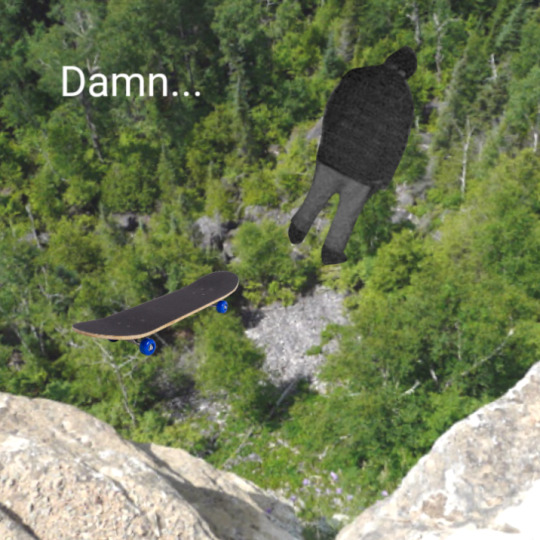
Don't even know what to say tbh.
For those that don't know, the big State of the Game article came out detailing incoming changes and adjustments and all the big stuff. Gambit was mentioned! But at what cost. Basically, they are ceasing any kind of support for Gambit. What we have now is what it is. We will get the Dreaming City map back in TFS and they will add Shadow Legion and Lucent Hive as enemy factions in TFS. That's all.
Full text:
As many of you have noticed, we’ve been quiet on Gambit since last year’s overhaul that launched alongside The Witch Queen. In that revamp, the team made significant changes across five categories in Gambit: core activity fundamentals, Primeval tuning, invasions, ammo economy, and rewards. Unfortunately, these updates didn’t move the needle for player engagement. Although we know our Gambit fans mostly care about new or returning maps, this is an area of the game with lower engagement that would take resources away from more popular parts of the game to shore up.
While we don’t have plans to dedicate more resources to significantly transform Gambit, we do have a few updates planned for the year of The Final Shape. These include porting the Cathedral of Scars map and its beautiful Dreaming City setting into the latest version of Destiny 2, as well as adding the Shadow Legion and Lucent Hive enemy types.
I don't know how to tell you this Bungie, but the reason "engagement is low" in Gambit is because Gambit sucks. Ever since half of it was removed with DCV, it just sucked. It has no variety, the gameplay is largely busted, it's not sufficiently updated, ammo changes suck, invasion cycle sucks (why is the enemy even getting a portal when their Primeval is at 5% health and the other team is still in mote collecting phase is beyond me), there are no cool armour sets to chase (just look at Iron Banner and Trials stuff, imagine dedicated cosmetics) and finally there are simply no weapons that are worth anything. Both Vanguard and Crucible have more weapons and also adept versions. There is zero reason to go into Gambit without major changes to Gambit. And now with the further changes to how playlists and challenges will work, there will be even less reason to go into Gambit. Observe:
Before then, we’re making Gambit entirely optional to maximize your rewards unless you’re looking for a piece of gear that’s specific to the mode. Gambit will continue to serve as a source of Exotic engrams via weekly challenges, though as we mentioned above, you’ll be able to complete all your weekly challenges in any ritual you’d like starting in Season 22. If you want to stick to Vanguard or Crucible challenges without touching Gambit, now you can.
We’re also reducing the number of Gambit-specific Seasonal Challenges starting in Season 22, so players won’t need to bank motes to be able to earn that big purse of Bright Dust for completing nearly every challenge in the Season. Finally, we’re adding Fireteam Matchmaking to Gambit next Season, which will replace the Freelance node and should result in faster, better matchmaking by combining both Gambit playlists. We’ll keep an eye on reception and player engagement after these additions take place, and we hope you’ll visit ‘ol Drifter next Season to get your hands on his new Void Machine Gun.
Ngl, but I don't think anyone besides like a total of 6 people will play Gambit next season. The incentive to go in there is completely removed. You won't even have to go in there for pinnacles or for challenges. The Void Machine Gun will not be enough of an incentive because the chance of that gun being better than two recently available craftable Void Machine Guns (Commemoration and Retrofit Escapade) is very low. And besides, once you get it at the end of your first match, you can leave Gambit forever.
This is the feedback loop that just reinforces the idea that people don't like Gambit. And I mean. Who would at this point. I'm pretty sure that if Crucible had stayed the same as it was at the start of Beyond Light, engagement would be low there too. But you know. Crucible has received major updates pretty much every season since with multiple new modes, several Trials overhauls, Iron Banner overhaul, competitive overhaul, new armours and weapons added and YES, even new maps. God forbid even 5% of these resources went into Gambit.
Anyway, this is the whole section about Gambit in 6500 words. It's basically a "you guys aren't playing this so we're doing the bare minimum of keeping it in the game as is, no new work will be done on it ever." Thanks I guess.
And for the record, something I also added while having a rant in my discord, I want to make it clear that I don't want anyone to spiral into a Bungie hate train. Even for this. I understand perfectly well what's the community attitude towards Gambit and what it's been for years now. People just don't like it and they're not incentivised to like it and they're actively encouraged to hate it. Spending resources into a game mode on the hope that maybe you can change people's minds would be insanity. Like, the amount of change Gambit would need to MAYBE start appealing to gamers would be beyond any reasonable time and resources Bungie can put in. And if you could guarantee that people would love and play Gambit then, fine. But you can't. Most likely, even if major changes happened, people would still just do their weekly stuff and bail. It's simply not worth it. In order for people to like it, it needs to be completely and thoroughly overhauled in a way that would need more time and effort than the entire Light subclass overhaul and it's just not a reasonable expectation, nor is it guaranteed to work. So I get it.
I'm still disappointed and annoyed about it because I believe it wasn't given a fair chance at all. I also know how good it can be and how Gambit Prime could've been improved upon over the years if they tried. Instead, it got removed and that was honestly the death sentence for Gambit. It's unfortunate. It's my favourite game mode that could've been so much better was it given even a fraction of attention of Crucible.
I'll still be playing it. You will find me in the Gambit queue waiting for 2 hours to find 7 other lunatics to play with, don't worry about it. But I'm absolutely incredibly sad about them being basically forced to axe the potential of the whole game mode that is incredibly creative and fits with the type of game Destiny is perfectly.
There's other interesting stuff in the article and some upcoming really cool improvements and changes to the game. But if you're a fan of Gambit in any capacity, this is a death certificate for the mode. I suggest coming to terms with it quickly because Bungie changing their minds about this is highly unlikely.
#destiny 2#gambit#ask#long post#says 'don't know what to say' at the start. writes an essay. FHKSJHFKJS#i won't go too much into it outside of this. we all know what this means no need to beat the dead horse#i'll still play it and the mode is still there but i expect a drop in quality and population significantly#the issues we have will never be addressed nothing will ever be fixed. we'll get a 5th map (returning) in 6 months and that's it#yay. I guess.#don't think there will be anyone in the playlist anymore by that point so I'm not sure why even bother with that alone#but still. if that does happen at least new people will be able to see that map now. it was very pretty#unfortunately not good gameplay wise. but at least it will help to not get deep six 17 times in a row#anyway. sad situation for gambit enjoyers. please don't turn into crucible bros to harass devs though
162 notes
·
View notes
Text
Dragons Quest XI: Echoes of an Elusive Age—A Review
WARNING: (not full) spoilers below.
‘We did it darliiiings!’
That’s what I cried, a-la the Great Sylvando, once I finished this game. 112 hours in, and all the way through it showed no signs of slowing. Which, for a shameless JRPG-lover like myself, is exactly what I want in a game. Hours and hours of combat, exploration through stunning scenery, empathetic and deep characters and, most importantly, a completely immersive and entertaining story that I can’t wait to see the climax—but, crucially, I can.

The Chosen One
The story begins in Erdrea, where monsters have invaded the fantastical world—why, we’re not quite sure. All we know, as the infant protagonist, is that we are found washed up on the riverbank by a kindly old man named Chalky, who takes us to his village and gives us to our adoptive mother, Amber.
And, guess what? He’s the Chosen One—the Luminary. You’d have thought our hero would have realised something was different about him with the presence of a very specific birthmark tattooed on the back of his hand, but he and his childhood friend Gemma do come from a sheltered town with very little knowledge of the outside world, after all. True to form for a lot of adventure games, he’s the only one who can save the world. After finding this out in a coming-of-age ceremony a few years later, Amber tells him to go to King Carnelian of Heliodor, who is sure to help him understand what all this means. Right?
If our silent protagonist could talk, this is where he would be screaming, ‘I’m not the Darkspawn!’ as King Carnelian throws him in the dungeon. But thank Yggdrasil he did, or we wouldn’t meet our first companion in our band of loveable misfits.

The Power of Friendship
I’m still unsure why, after so many hours of gameplay, why Erik endears himself the most to me, but he does. Sure, he’s the first one you meet, and you team up to escape the dungeon (running from a giant dragon along the way!), but he’s also a dishonest thief. Throughout the game, you never quite know if he’s in it for himself or to help you save the world. I’ve concluded that he’s actually doing it for you, and your budding bromance…or, at least, that’s my own head cannon. He’s misunderstood. His cutting sarcasm is welcome in a story of overly keen optimists (see: Sylvando). And he’s who the hero seems to look at whenever there’s a sweet, sentimental moment in the story, cementing their true friendship.
Or, maybe it’s because Akira Toriyama drew these characters, and his colourful hair and spunky attitude remind me of my childhood DBZ crush, Trunks. Either way, I’m Team Erik, with his knife-wielding, quick-thinking style of fighting, all the way. My only gripe is that his damage wasn’t that great for me until endgame, unfortunately.
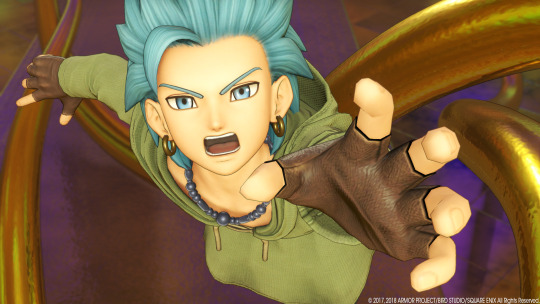
Even though we don’t meet Sylvando until later, it seems that my mind demands he be the next to discuss—much like Sylvando demands much of the attention within the game. We first meet him at the circus, where he is a beloved performer. His quest is to make the people of the world smile—a noble endeavour in a world where the Dark One is coming to rid the world of happiness for good. He is the absolute epitome of flamboyance: he calls your band of companions ‘darlings’; he has a half-naked ship captain with bulging muscles and a pink face mask called Dave, of all things; and he even leads a peacock-feathered parade at a certain point in the game, which the hero must cheerily join in, feathers and sassy sway absolutely necessary.
And yet, he doesn’t simply function as comic relief. He is brave, charming, sympathetic, and quite often the heart of the group. He is always the one to ask if a character is okay, or if they need help, and has conviction that only Henrik, our resident knight in shining armour, would rival. Plus, he’s fantastic with a whip (because of course he is) and has some fabulous healing moves that have saved me more than once in a tough fight. The group would be nothing without Sylvando—and he absolutely knows it!

Veronica & Serena serve as our other characters who are bound by destiny. They are Keepers, born to protect aid the Luminary on his quest. As twins, you’d expect them to look the same…but, after an encounter with monsters, Veronica was turned into a child, and is stuck that way. As an offensive mage who hates being treated like a child, she serves as the brash one of the group, quick to anger, much like her fiery spells.
Serena, on the other hand, serves as the yin to Veronica’s yang. She is temperate and always willing to help, if somewhat hapless. The primary healer of the group, she excels in restorative and defensive magic, and has a harp to while away the less hopeful days. As a pair, these two are steadfast, loyal, and…to be honest, aren’t much more interesting than that, unless Veronica is being goaded into an argument.
Until the later game, anyway. I won’t spoil that here, but will just say I underestimated both their spell casting abilities and their importance in the story.
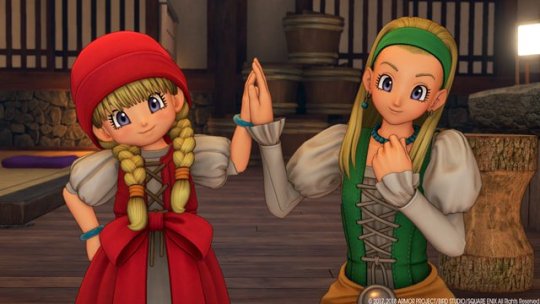
You know how the hero is the Chosen One, the Luminary and the absolute saviour of the world? Well, he also happens to be a Prince of Dundrasil. Had the fates been kinder, he might have been brought up in a huge castle, with loving royal family around to raise and guide him.
Rab, a fierce, playful and wise old man (with a banging Scottish accent) is ready to heal, attack with offensive magic, and guide our hero around the expansive world. And, as we find out after defeating him and his sexy companion in a battle competition in Octagonia (see: Jade), he is also grandfather to our hero, and thus a Lord of Dundrasil himself. He may seem old, but not only does he have royal blood, but he is a capable spell-caster and martial artist, making it apparent that he is one of the most capable companions in the game. If I were to ask anyone for advice, knowing that he would neither mince his words nor omit anything important, I would go to Rab.
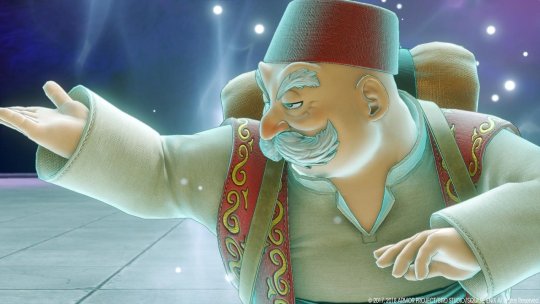
You know what any game directed at kids needs? That’s right, a sexy warrior princess that you can stick in a bunny costume for most of the game. Even if you choose not to do that, her combat outfit doesn’t leave much to the imagination.
Thankfully, Jade isn’t just eye-candy. She has far more going for her. She’s a Princess of Heliodor, the hero’s childhood companion who lost him as a baby. She just wants to find him, her younger brother figure (sadly), and help him fulfil his destiny. Plus, as a battle and spear fighter, she has some of the strongest moves in the game—albeit mostly from her sexy, love-based moves such as ‘Hip Thrust’ and ‘Sexy Beam’, only comparable with Sylvando’s equally as sexy and flamboyant ‘Lashings of Love’ and ‘That’s Amore’ moves. She’s a badass bitch who takes no crap from lovestruck men or monsters.
Though, she has her very own Princess Leia moment, where she is captured by a horrific, giant, evil and ugly monster and made to wear a sexy outfit (hey, there’s that bunny girl outfit again). It is heavily implied she has been under his mind control, and that he’s been having his ‘wicked way’ with her. Good thing she comes out of it with sexy vampire powers, isn’t it?
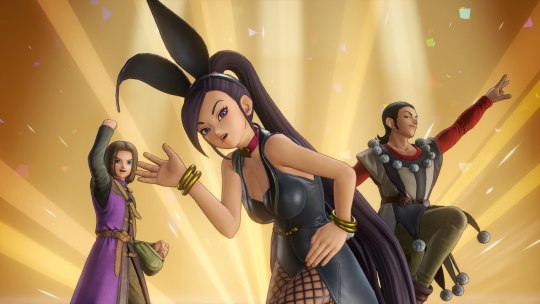
HEAVY SPOILERS NOW. I warn you, don’t go any further if you care about that kind of thing.
Our final companion is one who doesn’t show up until late game. Sir Henrik, a Knight of Heliodor, is the hero we all need. He defends his ruler to the last (which, spoiler alert, nearly ended up being his fatal flaw), is willing to sacrifice himself for the good of all, and defends the weak: a true knight, with chivalry, bravery, and total care for all others. It’s a shame he hated the hero for the first half of the game, really.
But do I care about that? No, I care that his greatsword abilities make him an absolute tank. On a one-on-one fight, I needed him front and centre of every battle just for his incredible damage output. Against multiple enemies, he is less useful, but with his supplementary healing and defence skills, he isn’t just an attacker, but a true defender of the people to the last.

Calm it with the Combat
My god, this game has a lot of battles. While that’s expected for a turn-based JRPG, and there were a lot, unlike others such as Pokémon, you can choose which battles to avoid as the figures traverse the overworld. This is useful in such a slow-burning game, and also helps you find the monsters you want—again, a definite improvement on the way Pokémon works, as it saves you having to fight hundreds of creatures you don’t want to find the ones with the best EXP.
A notable exception to this is when you have to find and defeat a rare monster for a quest, which don’t traverse the overworld. This means you have to fight potentially hundreds of more common monsters to find the one you want, which can be frustrating, especially as it is all done on chance and not on how many you have defeated. While you can increase your chances with various items or equipment, it still adds a frustrating amount of time to an already long game.
Another vague annoyance is how much harder the game gets post-game. I actually did not have an issue with this, as a friend told me how to farm the elusive and high-EXP metal slimes using a particular Hero-Erik-Jade Pep Power and so I could use this ability throughout post-game. However, for those not in the know, the potentially grinding at the end of the game may put some people off finishing an already saturated game.
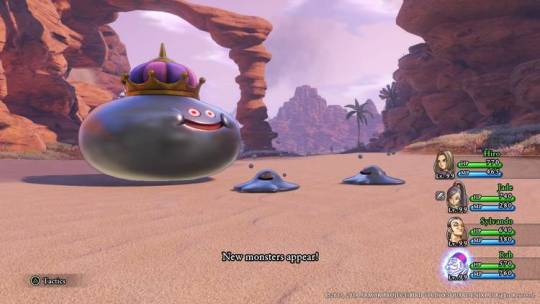
What I loved about the combat was how it kept getting harder and harder. I never worried about over-levelling (as said above, I was more worried about being under levelled) and that meant I could do what I do best: do all side-quests before the end of the main story. In other JRPGs, the completionist in me has always made me want to do all side-quests, but this has meant the final boss has been underwhelming and easier than it should be.
The variation of powers and attacks was also really interesting. You can spec into different forms of fighting for each character—I went for Swords with the hero, Whips for Sylvando, Boomerangs with Erik (after using Daggers for most of the game), Heavy Wands for Rab and Veronica, Wands for Serena, Spears for Jade, and Greatswords for Henrik—and this makes all the combinations of them in the party very cool. I normally just controlled the hero during the fights and let the others fight wisely, unless there was a specific quest to fulfil or a particularly hard boss. Not only did this speed up combat, but it also helped me to learn which of their moves were the most effective against which monsters automatically and quickly, which was easier than picking moves and trying them out myself. It’s easy, with enough gold, to respec if you like, and this I’m sure could make the game fee different every time if you wanted to play with different specs.

Pep powers were also a lot of fun. While it was sometimes annoying waiting for some or all of the characters to pep up and therefore use these moves that combine different characters’ moves for ‘Ultimate’ attacks, they provided fun cutscenes and made the battles more interesting. Plus, they reminded me a lot of DBZ moves, especially the epic ones with the hero and Rab!
Top tip: you can swap out characters and they will keep their pepped-up status. I wish I’d known about that a lot earlier!
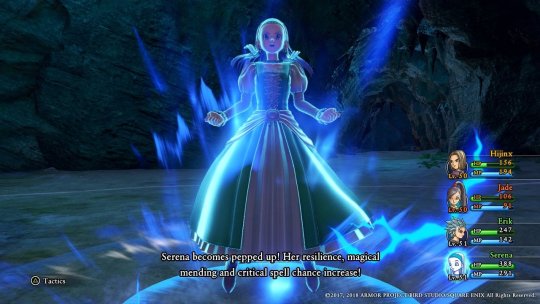
The monster designs are great, as per usual Akira Toriyama style. There are lots of different kinds, from slimes, to mechs, to really weird ones like the kissy lip monster and the Bongo Drongos. The bosses are also amazing. Just all the character designs, from human to monster, to anything else. I see a lot of DBZ in all of them, which is fantastic.
You know what? Here’s some pictures. You’re welcome.
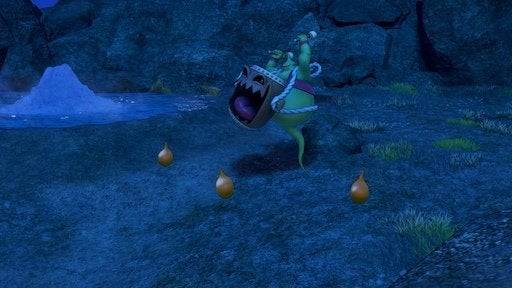

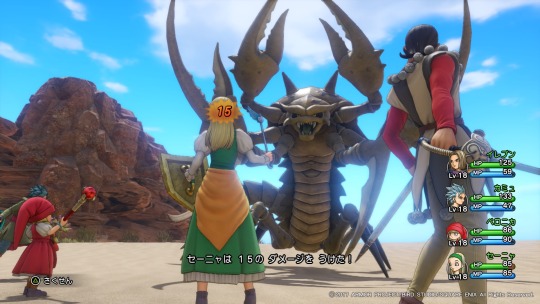
Mini Games & Challenges: Hey, I actually want to do these!
I often have issues with mini games, as sometimes they are so different from the main game that I just don’t want to spend time playing them. Gwent in another of my favourite games, The Witcher 3 is a good example: I never really learnt the rules, which I’m sure would have helped, but it was so detached from the main game I just didn’t care. Plus, it had no effect on the story or game at large, so what was the point?
In DQ11, sure, you don’t need to rack up 500,000 casino tokens in poker or the slots to buy better gear. You don’t have to finish first in all five Gallopolis horse races. Forging items isn’t totally needed to advance the game. It’s not necessary to win all five rounds of the Wheel of Harma in a certain number of moves (though this is much more like the rest of the game than the other mini games). But I did all of these, and it was great fun. It’s what’s helped make the game such a time suck (especially the casino) but I never felt like they were a chore.
Apart from the crossbow bullseyes. I did none of them as apparently I only noticed about three out of however many there are. They can suck my Sword of Light.

What’s a good JRPG without me questioning the point of life after it’s over?
JRPGs do it best—fight me.
The story of DQ11 is immersive, interesting, intricate and, at times, incredibly heart-breaking. Following the hero and his friends for over 100 hours really means you get to dive into their adventure, and more so, their relationships. You truly believe why they have chosen to follow each other into danger, to protect each other as well as the world. Sure, he’s the Luminary, so Serena & Veronica, the Luminary’s guides, at least have a reason to follow him to the end. The fact he’s the Luminary at may mean the characters have more faith in him than they would anyone else without lightning powers. But, even without that, you get the impression that they trust him for his innocent and yet resolute determination to do the right thing, whatever the cost.
The NPCs in the game also provide variety and are a lot of fun. There’s a lovesick mermaid, a brilliantly incompetent prince, two brothers in Laguna di Gondolia who are trying to sell the same things to you for different prices, and Silvando’s Smile Brigade, to name just a few. Their backstories, personalities and current stories all bring life to a game already chock full of it, and makes even simple fetch quests interesting and well worth doing, if you value a good story like I do. These little touches explain why the game clocks in at well over 100+ hours, but at the same time gives true justification to why that is. It’s the difference between a boring game, and one I loved to turn on and just relax of an evening. I might not have done all that much in three hours, but I still enjoyed every minute.
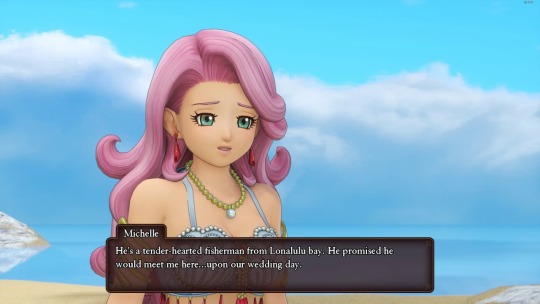
With everything considered, I will remember DQ11 fondly as one of my favourite JRPGs to date. The storyline, characters, combat and score are all fantastic and makes me wish I played the older games. Thank you, Dragon Quest, for giving me 112 hours of fun.
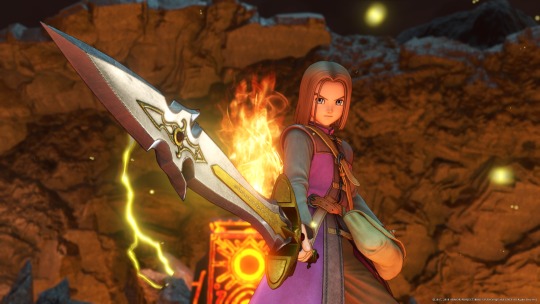
37 notes
·
View notes
Text
5e Pyke the Bloodharbor Ripper build (League of Legends)
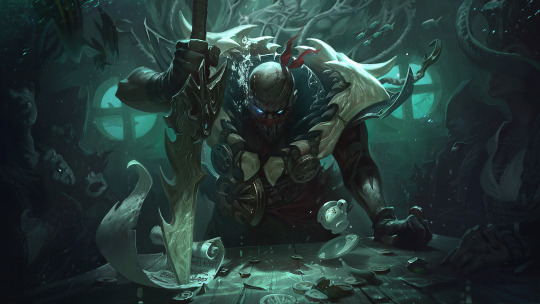
(Artwork by Riot Games)
You look familiar... You. You were on my blog, looking at my builds.
Well here’s yet another League build, and yet another edgelord champion. I don’t know if it’s a problem with me or a problem with League but I seem to be drawn to characters with edgy personas... at least lore-wise. In game I spam Sona and Yuumi like an eGirl thot.
And Kayn. And Warwick. Alright I might just be an edgelord.
Regardless Pyke is always a character I’ve enjoyed more for his lore than his actual gameplay. Back in my DOTA days I used to main Bounty Hunter (and I might branch out to DOTA builds someday; who knows?) and while Pyke captures that gameplay to some extent he’s never really been my cup of tea. Gondar was considerably more light-hearted than Pyke and focused a lot more on information gathering than the raw killing that Pyke does. Even so I think Pyke was a great addition to the lore of Bilgewater with the rest of the region seemingly existing only as an excuse to put pirates into League of Legends. (Ironically enough I actually think the other character that displays Bilgewater’s lore the best is Tahm Kench, and considering that most people see him as a meme that’s really saying something.)
But regardless: you’re here for the build, not to read me ramble about why I made it. I can definitely say that if you genuinely want to play Pyke you’re certainly one for the roleplay, though try not to be overly edgy.
GOALS
Harpooner - Armed with an iconic Bone Skewer it’ll find its way stabbed into the stomachs or thrown into the backs of many victims.
Until it all sinks... - Pyke swims in the shadows before surfacing to pounce his prey. He did also swim in the water once.
Did I “support” right? - While we won’t have any healing Pyke has plenty of utility in his own right.
RACE
Officially Pyke is some sort of drowned revenant, and while I know there is a Revenant race in the Gothic Heroes UA it’s rather unbalanced and unfortunately doesn’t really work for what we’re trying to do here. The Gothic Heroes Revenant has a goal, but Pyke’s mind is warped so he thinks his goal is never done. While the health regen is in character for Pyke’s Gift of the Drowned Ones the other features don’t really help us or retain the aquatic theme of Pyke.
With that in mind I had a few ideas: Water Genasi was my first idea to have a character infused with the strength of the sea but unfortunately it’s focused far too much on magic as well as Constitution, both of which Pyke doesn’t have. My next thought was for a Kalashtar to have the spirit of the drowned one infused into you, but they’re tied deeply into their dream lore and less-so into the two-minds aspect.
But then I realized there’s a race that gets infused with parts from the ocean, and even starts out human just like Pyke! This is going to sound mad but you’re going to want a Simic Hybrid from Guildmaster’s Guide to Ravnica. While in-lore they receive their gifts from the deep from science we can reflavor it as gifts from the ocean itself. Anyways Simic Hybrids see their Constitution increase by 2 and a stat of their choice increase by 1: choose Dexterity for a better chance fighting the beasts below before your line is cut. You also get Darkvision up to 60 feet and Animal Enhancements. Since Animal Enhancement is tied to level I’ll be addressing it in the build instead of in the race section because this is getting long enough as is. And for your language of choice I’d opt for Elvish, mainly because it’s unlikely you’ll meet any Vedalken this side of the sea.
ABILITY SCORES
15; DEXTERITY - Fighting the monsters of Bilgewater in their own territory takes a great degree of nimbleness to avoid getting your line cut.
14; CHARISMA - All sea captains fear the Bloodharbor Ripper, and Charisma is a requirement to multiclass.
13; INTELLIGENCE - You need to be smart to hunt any prey, be it a monstrous fish or... more dangerous game...
12; CONSTITUTION - While not in-character for Pyke to be tanky we sadly can’t convert our health into damage in this build.
10; WISDOM - Even if you have to do it to survive jumping into monster-infested waters is not the best lifestyle choice.
8; STRENGTH - While perhaps in-character to drop Wisdom instead we simply don’t need Strength in this build.
BACKGROUND
There are several backgrounds for a man lost at sea but Pirate is the best for one who came back with a vengeance. You get the Athletics and Perception skills to scout out your prey and wrestle with it in deep tide, as well as proficiency with Water Vehicles and Navigator’s Tools to command your own ship someday. But the main feature we’re here for is Bad Reputation so everyone knows that you’re the Bloodharbor Ripper. If you’re in a civilized settlement people will be afraid of being put on your list, and will let you get away with minor crimes. Murder isn’t a minor crime though, so pull someone into an alley if they do end up showing up on your list.

(Artwork by Riot Games)
THE BUILD
LEVEL 1 - ROGUE 1
Starting off as a Rogue for the extra proficiencies: take Intimidation, Stealth, Investigation, and Acrobatics as your skills of choice. You also get Expertise in two of those skills and you’re going to want Investigation to find your quarry and Stealth to sneak up on them.
But of course the main reason for the expertise in Stealth is so we can Sneak Attack. Once per turn you can do an extra d6 damage with an attack if an enemy is within 5 feet of your ADC or if you have Advantage on the attack by jumping out of water. You must be using a finesse weapon such as your Bone Skewer, which for now would likely just be a Short Sword since you haven’t received your gifts from the deep yet.
But your time in Bilgewater did allow you to learn Thieves’ Cant, a mix of words and phrases that are actually a code among criminals. They may be speaking about the latest big catch but you know what they’re really talking about is cutting your line.
But while you were under the undertow you did receive some Animal Enhancement. As a Simic Hybrid you can choose between three Enhancement options at level 1: Manta Glide lets you fall slowly and glide as you do so, Nimble Climber gives you a climbing speed equal to your walking speed, but Underwater Adaptation is the obvious choice for the drowned man. You gain a swimming speed equal to your walking speed and can breath underwater. You drowned once but it won’t happen again.
NOTE: If you’re playing outside of an aquatic campaign Nimble Climber would be your next best bet to remaining in character. You can also opt to just play a Variant Human instead of a Simic Hybrid if you don’t mind the lack of swimming speed however, since Simic Hybrid was mainly picked for the aquatic implications.
LEVEL 2 - ROGUE 2
Second level Rogues get Cunning Action, allowing you to use your quick wit to Dash, Disengage, or Hide as a bonus action. A Bilgewater Harpooner needs to be quick on their feat and always trust their crew. But when that trust is lost...
LEVEL 3 - WARLOCK 1
As you’re lost to The Drowned Ones you receive their blessing to become a Warlock. The Drowned Ones could be seen as The Undying in many senses, as they keep you from death to serve them.
WHY NOT LURKER IN THE DEEP? - Lurker in the deep focuses a lot more on using the strength of those below more directly. Pike meanwhile merely serves them as an assassin. Not only that but Lurker in the Deep has far more of a focus on tentacles than knives, which is more of Illaoi’s thing.
Undying Warlocks are considered Among the Dead. They get the Spare the Dying cantrip and have Advantage against diseases, and undead enemies may not attack you as they see you as one of their own. If an undead attacks you they have to make a Wisdom save against your Warlock spell DC or choose a new target, losing the attack if there is no one else to hit. If you succeed on the save or you hit them they’re immune to this effect for 24 hours, so perhaps don’t pick fights with Sion.
But along with Spare the Dying you also get access to more Spellcasting. You learn 2 cantrips from the Warlock spell list: Lighting Lure will let you throw your Bone Skewer out at an enemy within 15 feet. They must make a Strength saving throw or be pulled 10 feet towards you, taking a d8 of Lightning damage if they’re pulled into melee range. Eldritch Blast lets you throw your Bone Skewer further down range - make a ranged spell attack against a target you can see and on a hit they take a d10 force damage.
You also learn 2 first level spells from the Warlock list: False Life comes from The Undying patron list and lets you “regenerate” some health in the darkness. You gain a d4 + 4 temporary hitpoints when you cast this spell. That temp HP lasts for an hour or until it’s cut off of you.
Illusory Script meanwhile is the perfect spell to write your list. You can cast this spell while writing with lead-based ink worth at least 10 gold to imbue the words with powerful illusion magic for 10 days. Creatures you designate can read the message normally but any other creature won’t be able to read it, or will see a completely different message as long as it’s written in a language you know. If the spell is dispelled the message is dispelled, so no one will know that your list is truly unending... unless they have truesight, as they’ll be able to read it under the light of a pink ward.
LEVEL 4 - WARLOCK 2
2nd level Warlocks get Eldritch Invocations and the only one we really need is Grasp of Hadar. Every time you hit an enemy with your Eldritch Blast you can pull them 10 feet closer, so you can drag ‘em under and get your hands dirty. You other choice of invocation really doesn’t matter: Armor of Shadows can be a good boost to your AC but I personally like Mask of Many Faces to hide behind your facemask before finding your prey.
You also get another spell and Hex will let you mark your prey as a gift to the Drowned Ones. Whenever you hit a target that’s Hexed you do an extra d6 Necrotic damage, and the target has disadvantage on a type of ability check of your choosing. I’d personally choose Strength so that they can’t swim up when you pull them down to drown.
LEVEL 5 - ROGUE 3
3rd level Rogues get access to their Roguish Archetype and the Soul Knife subclass from the Psionics UA will make sure you always have a Bone Skewer. The Soul Knife gets a Psionic Enhancement: you can either have a 30 foot Telepathy, some extra health and Toughness equal to your Intelligence modifier plus your Rogue level, or 5 feet of extra Walking Speed. These all have their uses but while it’s perhaps not in-flavor Toughness is probably your most consistently useful enhancement.
WHY NOT REVIVED? - Revived focuses far more on the manipulation of death, and has a heavier skill focus than the Soul Knife. But put in simple terms Soul Knife has nearly all the abilities I’d want from Pyke without having to multiclass too much. Undying Warlock is already more than enough undeath for Pyke, and it also helps give him some Deep One patrons.
I should also mention I made this build before the latest Psionics Options Revisited UA. This build uses old features so discuss with your DM if you want to use the newer version.
But of course the main reason to go for the Soul Knife is your Psychic Blade. You can create a bone skewer in your hand, or two bone skewers if you’re feeling particularly vicious. You can’t hold anything in the hand you hold the blade but you can choose to dispel them without using an action.
The blade has the finesse and light properties so you can dual wield them and use your Dexterity as your attack modifier. It deals 1d6 psychic damage on a hit and you can throw it 30 feet normally or 60 feet with disadvantage. Regardless of if you throw your knife or stab with it you can proc your Sneak Attack, which now deals 2d6 damage. If you throw the blade as part of an attack it vanishes immediately after it hits or misses, and the blade(s) disappear the instant it leaves your hand or if you’re incapacitated.
You also get another Animal Enhancement as a Simic Hybrid so you may as well get more AC from the Carapace enhancement, which increases your AC by 1 as long as you’re not wearing Heavy Armor. The only other enhancement I’d maybe suggest is Nimble Climber, which you could’ve taken at level 1. But simply put more AC is more useful, and was limited to us for a reason. You can consider the extra AC as the salt soaked into your skin, and your lust for vengeance allowing you to shrug off attacks.

(Artwork by FMM CAT)
LEVEL 6 - ROGUE 4
4th level Rogues get an Ability Score Improvement: increase your Dexterity for deadlier strikes with your Bone Skewer.
LEVEL 7 - ROGUE 5
At 5th level Rogues get Uncanny Dodge, letting them reduce the damage of an attack by half as a reaction. Is a female bounty hunter shooting you? Dive in the ghostly waters and set yourself up for the kill, especially since your Sneak Attack is also increased to 3d6 at this level.
LEVEL 8 - ROGUE 6
6th level Rogues get Expertise in two more skills: I’d choose Intimidation and Athletics. A frightened target won’t be able to lie to you, and Athletics Expertise will compensate for your low Strength score.
LEVEL 9 - ROGUE 7
7th level Rogues get Evasion: if you’re targeted with a Dexterity-based skill shot you can dash out of the way and take no damage on a successful saving throw, or only half damage if you fail. Pyke is far more evasive than the average support, and can get up and personal to do 4d6 with Sneak Attack.
LEVEL 10 - ROGUE 8
8th level Rogues get another Ability Score Improvement and we’ll max out our Dexterity for even deadlier strikes with your Bone Skewer.
LEVEL 11 - ROGUE 9
At 9th level you get the Terrifying Blade Soul Knife feature. When you damage a creature with your Psychic Blade you can force them to make a Wisdom saving throw based on your Intelligence modifier. If they fail the creature is frightened of you until the start of your next turn, but on a successful save they become immune to this feature for 24 hours. Traitors run from their past, or face them head on. Regardless you’ll kill them all, especially with a 5d6 Sneak Attack.
LEVEL 12 - ROGUE 10
10th level Rogues get another Ability Score Improvement, and you may have noticed our uneven Intelligence score? The Observant Feat will let us see when traitors talk about their coin. You can increase one of your mental stats by 1 (we’ll improve Intelligence) and you can read a creature’s lips to understand what they’re saying as long as you share a language. Your passive Perception and Investigation also increase by 5, so you can be aware of any backstabbers trying to slip away.
LEVEL 13 - ROGUE 11
11th level Rogues get Reliable Talent, meaning that any roll below a 10 in a skill you’re proficient in is treated as a 10. This means that your lowest possible roll with the skills your proficient in is:
25 on Stealth
22 on Intimidation or Investigation
20 on Acrobatics
19 on Athletics
15 on Perception
Your Sneak Attack also increases to 6d6.
LEVEL 14 - ROGUE 12
12th level Rogues get another Ability Score Improvement and we’ll want more Intelligence to know how to truly terrify our foes.
LEVEL 15 - ROGUE 13
13th level Soul Knife Rogues can dive into spectral waters with Psychic Veil. As an action you become invisible for 10 minutes. This invisibility ends if you make an attack or if you force a creature to make a saving throw. You can become invisible a number of times equal to your Intelligence modifier and you regain all expended uses when you finish a long rest. Your Sneak Attack also increases to 7d6 now, and just so you know attacking out of Invisibility counts as a Sneak Attack.
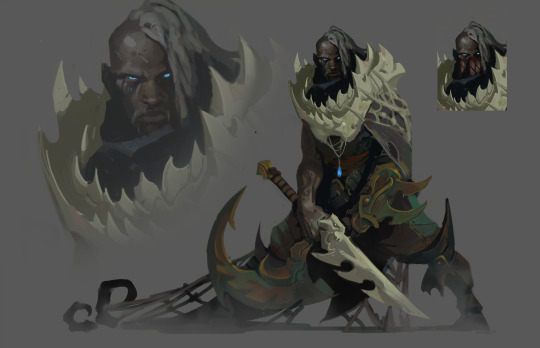
(Pyke concept art by Riot Games)
LEVEL 16 - ROGUE 14
14th level Rogues borrow some techniques from the monk in the jungle and get a 10 foot radius Blindsense to chase your prey.
LEVEL 17 - ROGUE 15
15th level Rogues get Slippery Mind for proficiency in Wisdom saving throws. It’s not much but considering that you have a +0 to Wisdom it certainly helps. Your Sneak Attack also increases to 8d6 now.
LEVEL 18 - ROGUE 16
16th level Rogues get another Ability Score Improvement and more Intelligence will lead to more Ghostwater Dives and better Terrifying Blades.
LEVEL 19 - ROGUE 17
17th level Soul Knife Rogues can Rend Mind for a powerful Phantom Undertow. If you have a Psychic Blade manifested you can force a creature you can see within 30 feet of you to make an Intelligence saving throw. The target takes 12d6 psychic damage and is stunned until the start of your next turn on a failed save, but only takes half as much on a successful save and isn’t stunned. If you are hidden from the target it has disadvantage on the save, and one of your Psychic Blades vanishes after using this feature.
You can use this feature a number of times equal to your Intelligence modifier and regain all expended uses when you finish a long rest. Pro tip: attacks against Stunned enemies automatically have Advantage so you can use your 9d6 Sneak Attack damage.
LEVEL 20 - ROGUE 18
Our final level is the 18th level in Rogue for Elusive so that no attack can have Advantage against you. "Death keeps spitting me right back out."
FINAL BUILD
PROS
I smell panic - Soul Knife on its own is a very powerful subclass. Having an unlimited supply of weapons that are viable at both melee and range, the ability to turn invisible, and tons of crowd control with both fears and stuns makes for an incredible damage dealer who can provide a lot of utility to the party.
Big Beast - It wasn’t my intention when making this build but for a Rogue you’re remarkably tanky. You have an above-average constitution and Psionic Enhancement buffing your health to a respectable level, and the Carapace Animal Enhancement turns what would be a +5 to AC (from your Dexterity) to a +6. This means that you have 17 AC with Leather Armor, 18 with Studded, and a 19 AC with Armor of Shadows! As a Rogue, meaning you have Uncanny Dodge and Evasion to further increase your survivability! Not to mention you have two Warlock slots to cast False Life is the fight starts to go south.
Crews share the wealth - Expertise in Intimidation and Investigation are helpful, and having Spare the Dying means that your Cleric can focus on stronger cantrips instead. But having 10 minutes of invisibility is insanely helpful for infiltration.
CONS
Every kill makes the voices louder - The two levels in Warlock are done almost entirely for flavor, and while we do get some useful features it does still mean you lose out on Stroke of Luck. If you have a DM who likes roleplay you can take the Magic Initiate feat for Wizards to get Lightning Lure along with potentially Ray of Frost to simulate a long-ranged “pull” and be a Warlock without actually being a Warlock. But the honest truth is that Soul Knife on its own is strong enough and the ability to pull people closer to you is largely redundant.
My list just got longer - Soul Knife uses their Bonus Action a lot more than other Rogues, meaning that you can’t use your Cunning Action to hide as often. Yes you can make two knives at a time but this still means that you’ll have to spend another bonus action to “reload” after throwing two hooks. And if both your hands are full you can’t hold your list!
Swim or Sink - Unfortunately you don’t get to max out your Intelligence modifier, which is needed for a lot of your class features. However the far bigger issue is your saving throws: proficiency in Wisdom saves help but your Charisma and Constitution are stuck at +2 and your Strength is forever at a pitiful -1. While you can compensate for strength checks with Expertise in Athletics your saving throws are less than desirable.
But problems only come for those without a plan. Make your list, check it twice, find out who’s naughty or nice before gutting them. Make sure your crew’s got your back and that they aren’t going to cut your line too. You’ve died before, but it doesn’t hurt not to do it again.

(Artwork by Riot Games)
18 notes
·
View notes
Text
Ys 1 & 2 review: the 22 year long journey to American computers
Falcom is one of the big underdogs of Japanese game developers, at least outside of Japan, a role pretty unfair for them considering they’re also one of the most important Japanese game developers to exist. Before names like Final Fantasy and even Dragon Quest were around, Falcom was pioneering action RPGs, JRPGs, and even innovating video game music as a whole. Dragon Slayer, the title that set the foundation for action RPGs, would eventually transform into the Legend of Heroes, better known as the Kiseki, or Trails, series, boasting some of the most detailed JRPGs out there, while the other big innovator, Ys, would remain true to its roots, while still taking steps to innovate as much as possible with every new title. Despite their games both being very influential and just plain great in of themselves, Falcom was basically unknown outside of Japan for decades due to very inconsistent localizations, and mostly being released on more niche consoles even when it did happen, like the Sega Master System or the TurboGrafx-16. The only Ys game to make it to American shores on the Genesis or SNES was Ys 3, which was barely recognizable as an Ys game in its original form, gameplay wise, and the first exposure America got to the Legend of Heroes was the Gagharv trilogy on the PSP, which recieved such awful localizations that they were actually released out of order, with the second game actually being released first, instead of the actual first, cause that certainly isn’t capable of causing problems. Thankfully, since 2010, XSEED has delivered fantastic localizations of many, many significant Falcom games released both before and after, giving fantastic games like Trails in the Sky exposure only dreamed of before. They’ve still got a ways to go, though, and so, it’s time for me to show my appreciation for these games by covering Ys 1 & 2, the games that refined the action RPG genre, farther than just starting it. The version I’m covering is Ys 1 & 2 Chronicles Plus on Steam and GOG, one of the most recent, and refined, versions available, and is based off the PSP version, which is based off the PC remakes. It’s a pretty crazy history for these games.
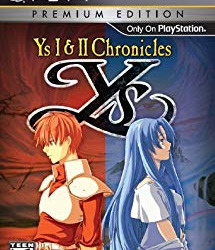
Ys 1: Ancient Ys Vanished: Omen
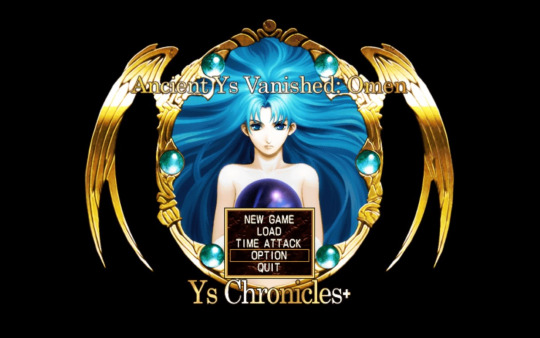
Story:
The story of Ys 1 is about the titular land of Ys (pronounced ees, like ease, or the middle part of geese), a mysterious floating island, which was, in ancient times, part of the island of Esteria. Ys was said to be watched over by twin goddesses and six great priests, named Tovah, Dabbie, Hadal, Mesa, Gemma, and Fact, until a mysterious evil forced them to raise Ys into the sky, with a few descendants of the priests and a gigantic crater being among the only remnants of Ys left in Esteria. 700 years later, odd things are happening in Esteria, with a wall of storms appearing to surround the island, cutting it off from the rest of the world. On the island itself, monsters have suddenly appeared as well, and something is stealing anything made of silver from the inhabitants, even resorting to assault. In the middle of this, the red haired swordsman Adol Christin, fueled partly by intense wanderlust, sets off to Esteria to investigate... only to predictably shipwreck against the Stormwall, washing up on the island and being rescued by the citizens of port Barbado, setting a fantastic standard for himself to repeat several times in future games. After setting out and reaching the town of Minea, Adol allies with the fortuneteller Sara, a descendant of priest Tovah, and sets off to collect the 6 Books of Ys, written by the priests, said to contain the secrets to the rise and fall of Ys, and the power to save Esteria, along the way meeting Feena, an amnesiac girl specifically imprisoned by the monsters, Reah, a troubadour with a silver harmonica, Luta Gemma, another descendant of the priests, and Adol’s future traveling companion Dogi, who has a hilariously small role considering his role in future games.
It’s definitely nothing too deep by today’s standards, not helped by the game’s short length, but having such an old game, we’re talking 1987, have an active focus on the story is pretty impressive, and to its credit, it does manage to make Ys genuinely mysterious, with an interesting explanation behind its fall, namely, the valuable metal of Ys, Cleria, caused the summoning of demons, and its discovery in Esteria, mistaken for silver, led to the island’s current troubles. While the characters as a whole aren’t anything special either, they have a likeable quality to them, and the main villain does have a fairly interesting twist to him; he’s also a descendant of one of the priests, Fact, out to collect the books for his own purposes. That said, the main strength of writing is just the general dialogue itself. For such an old game, the remakes added a lot of detail to the NPCs, giving everyone a name and a personality, and the translation gives a lot of life to them, making them pretty fun to talk to, turning what would otherwise be a lot of empty dialogue into amusing moments. They even gain new dialogue after certain points in the plot, which is another nice touch.
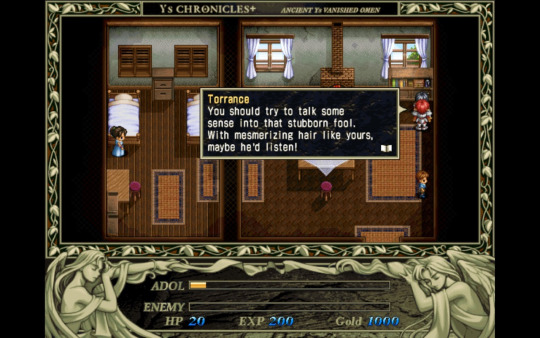
Overall, though, the biggest strength concerning the plot itself is the actual dedication put into it just relative to the time it was released. Touches like the Books of Ys being in a completely different language than what Adol knows, forcing him to find a way to translate them, and Luta Gemma’s mentions of guiding dreams, something that would become a much more common occurrence in the sequel. Speaking of which, this game was clearly betting on having a sequel with its plot, which is a pretty ballsy move even now. The deeper details to the downfall of Ys, the mysteries behind characters like Feena and Reah, and just what Ys itself is really like are left unanswered, with the game ending on an outright cliffhanger, with the books transporting Adol to Ys after saving Esteria, very likely one of the first video games to do so, at least in regards to following up on it. Overall, the writing side is still entertaining enough, and as long as it manages to be fun, that’s a success in my book.

Gameplay:
Here’s where stuff gets a bit, let’s say, contentious. Ys is played at a top down angle with you controlling Adol, and only Adol. Combat, compared to almost any other video game, even from the 80's, is rather unusual. You see, instead of using a dedicated attack button, Adol suffices with ramming into his enemies, swinging his sword and damaging them automatically on contact. This system, called the Bump system, may sound, well, dumb and overly simple, but it’s quite a bit more complicated than it may seem. Running directly into an enemy, rather sensibly, kills Adol dead in just a few hits, though he at least trades hits with them as well. In order to attack safely, you need to hit them at a vulnerable angle, such as to the side or behind them. Thankfully, you don’t need to pull hit and runs for every individual attack, as once you hit an enemy at a good angle, you can just keep moving forward and attacking, with them being unable to resist unless you choose to move away, or are knocked back by another enemy. While it can be difficult to put to use at first, it’s actually a fairly well designed system. It gives the game a fast and surprisingly intense pace, with enemies being able to kill you in just a few hits, and having telegraphed attacks of their own in addition to being able to hurt you just through collision. On the opposite side, being able to run into enemies and kill them in a second is pretty satisfying, and makes grinding for EXP and gold a lot less troublesome than usual in RPGs, considering you can just take things down on your way to something else. The game also takes mercy and allows you to automatically regenerate your HP on the overworld and in towns just by standing still for a few seconds, and considering enemies only respawn when you move the screen, it isn’t much of a risk to you either to just stop and take a breather.

Adol’s equipment consists of swords, shields, armor, and rings. The first three are pretty self explanatory, boosting his attack and defense, and acquired by buying them in shops, finding them in treasure chests, or even received from NPCs for free in a couple of cases, while the rings give effects like boosting attack or defense, slowing down enemies, or boosting health regeneration, either doubling it when Adol is outside, or allowing it in dungeons, where it is normally restricted, though unfortunately the rings do not work in boss battles. Adol also has a regular inventory, mostly containing key items, including a few equip able ones like a mask revealing secret passages, and a few other things like potions to restore health and wings to instantly transport him back to Minea. As this is an RPG, there’s also a leveling system, which gives Adol downright dramatic stat increases each time he gains a level. Problem is, these levels matter way more than equipment, and with the jump between each level, the early game consists of just grinding a few levels until you’re capable of taking on the next set of enemies somewhat safely, with several bosses in particular being outright immune to damage until you reach certain levels. At the least, you don’t have to do this many times, considering the level cap is only 10, which you need to reach to beat the third boss out of seven, after which you’re at the mercy of any equipment the game gives you to get any stronger. Speaking of which, bosses mix up the gameplay a bit by being vulnerable at any angle, meaning you just have to focus on getting to them in between their attacks. Unfortunately, most of the bosses aren’t exactly great, either being really easy, or really, really annoying, with special mentions going to the previously mentioned third boss, which spends most of its time as a swarm of bats capable of covering most of the screen, only being vulnerable when it reforms for the briefest of moments, and we’re talking barely a second. Sometimes it’ll reform almost immediately after transforming, but other times it’ll chase Adol much longer, and it stays as the bat swarm longer if you get hit. It doesn’t take much damage even when you do hit it, as a cherry on top, making for a very drawn out fight.
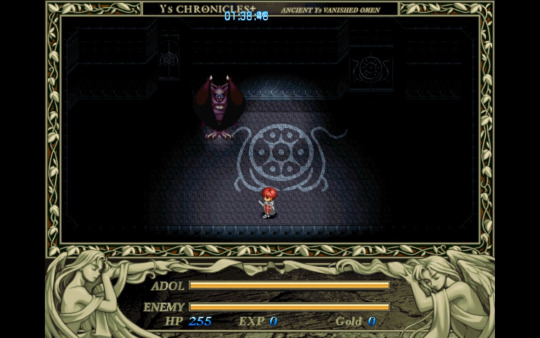
The 4 bosses after this one are a lot more fun, at least. From a giant mantis that constantly throws scythes at you, to a giant rock creature constantly firing projectiles at near bullet hell levels, to two giant floating heads bouncing around a room with barriers around them, forcing you to slip in between the barriers to hit while they swap between who is vulnerable, they’re legitimately intense, and a lot of fun, culminating with Dark Fact himself as the insane final boss, ping ponging around a room, firing near impossible to dodge projectiles, turning it into a game of rushing to meet him once you can predict his path and damaging him as much as you can, while he destroys parts of the floor for every hit he takes, killing you if you’re not on a different tile when he destroys it. It’s a nightmare attempting it at first, especially since you can’t even use your best equipment, as he is immune to any sword that isn’t the silver sword, and will kill you near instantly if you don’t use the silver armor and shield, and the instant death floor destruction is a cheap move, especially since you can outright get trapped if the right tiles get broken, nearly always forcing you to reload. Still, it’s actually pretty fun once you get the hang of it, and certainly lets the villain live up to the hype he built up. It should be mentioned there’s also a time attack mode that lets you go through a boss rush. It’s actually pretty fun, if let down by some of the roadblocks a few bosses present.
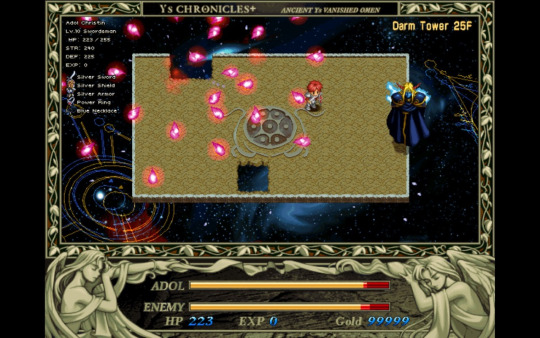
While at its core, Ys is an enjoyable time, there is one pretty difficult to ignore aspect to it: it is a very short game. There’s only three towns, a fairly small overworld, and three dungeons to go through. The first two dungeons, an old palace and a mine, are pretty decently lengthy, with quite a bit of stuff to find, but otherwise, it’s just a lot of backtracking and grinding. There’s not much in the way of puzzles, either, mostly only a few in the final dungeon. Once you’re forced into Darm Tower, with a full set of silver equipment and half of the books in your possession, you don’t think this last dungeon will be much. But that’s when the game throws you for a loop. Darm Tower is a behemoth of a dungeon, at a massive 25 floors you have to trudge through, with plenty of detours and backtracking. There’s new enemies every few floors, and 4 whole bosses are contained in this place. In the original versions, it easily took up half the game, and even in the newer versions, it’s a third of the game at minimum, if you spend enough goofing off. I have some mixed feelings towards this place. It’s miserably long and difficult, that mostly just has the same look to it in each floor, and even the music is the same until towards the end, not to mention once you go in, you’re stuck, and forced to keep on marching until you reach the top. On the other hand, I kinda like it just because of how unique it is. Darm Tower is hyped up even during the intro to the game, and plenty of NPCs say it to be an awful, fearsome place. If you’re savvy with RPGs, you might figure it won’t live up to that... but no, it lives up to all the hype it’s given. It’s utterly massive and exhausting, with tons of dangerous enemies that’ll hunt you down relentlessly. They’re even able to stick in plenty of plot and characters within, and seeing the day slowly turning to night as you make progress is quite a sight. In just living up to, and even surpassing, this hype, I kinda have to respect it. Overall, the gameplay of Ys works a lot better than you’d expect, successfully polished through over 20 years of remakes, but the short length alone could make it a difficult recommendation on its own.
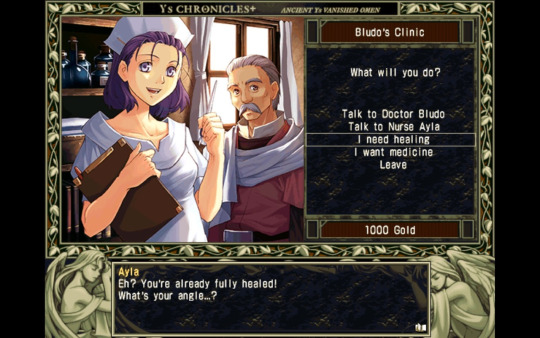
Graphics:
Ys is actually a very pretty game to look at. The characters and regular enemies are in a sort of chibi style, which is pretty adorable, but not too detailed by themselves. The environments, on the other hand, look great, with lots of little details and allowing some fantastic views. While the enemy designs and locations aren’t anything too special, they still look quite good, especially the bosses, which are significantly bigger than normal enemies. Enemies also explode in a cloud of blood, bones, and body parts when defeated, which is both funny and satisfying, while not being anything too gruesome. You may have also noticed the border portrait in these screen shots, which I find quite nice to look at, if a bit restricting. You are allowed to go completely full screen, though, if it’s not to your tastes, but it doesn’t actually cut anything off.
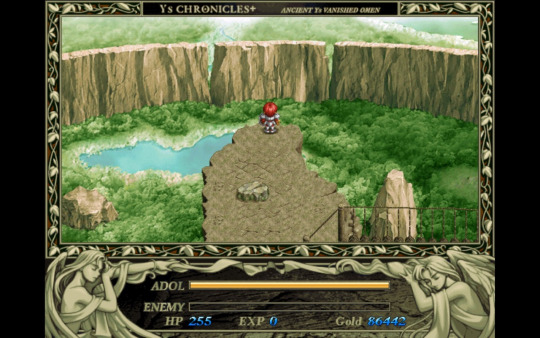
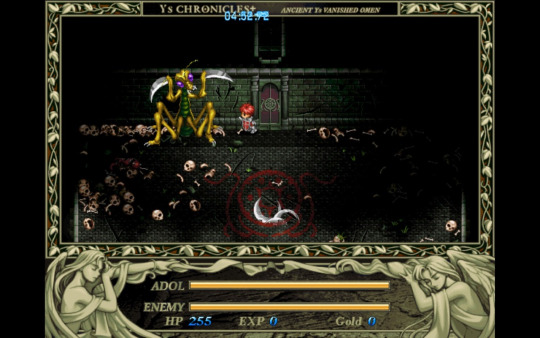
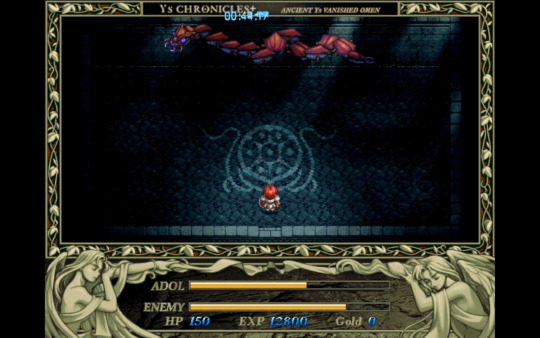
The best aspect of the visuals, though, is the character artwork used when talking to important characters. It looks absolutely beautiful, and is a good contrast against the otherwise lesser detailed sprites.
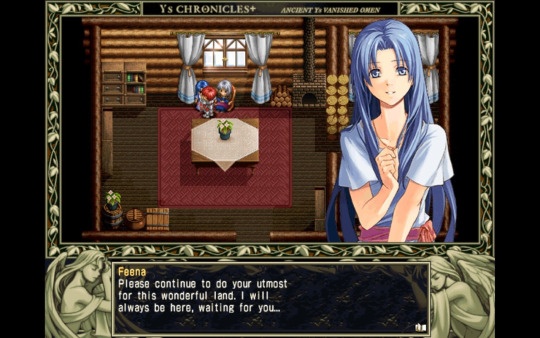
This version also goes above and beyond in this regard by giving you options regarding this character artwork, namely a choice between using the newer artwork made specifically for this version, Ys 1 & 2 Chronicles, and the older artwork originally used in Ys 1 & 2 Complete, the PC remakes that have served as the basis for almost every port of these games since their release. Which you use comes down to a matter of preference, and while I do find the Complete artwork to look a bit odd at times, overall both options are beautiful. (Chronicles artwork is used first in these comparisons, and Complete artwork is used second)
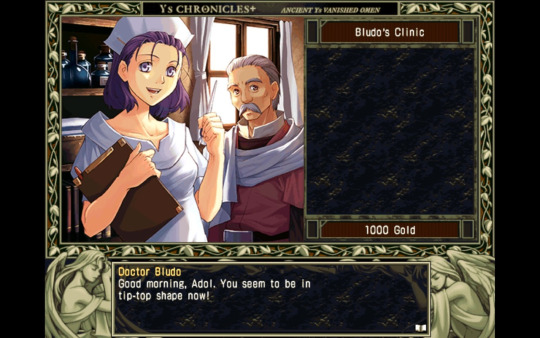
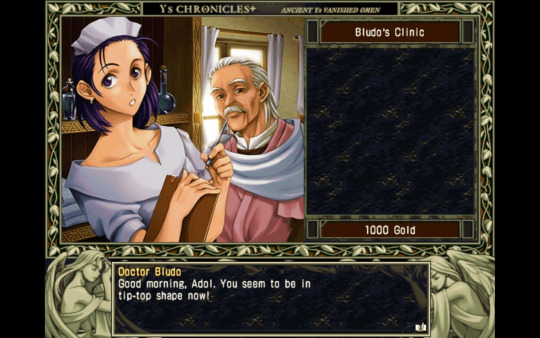

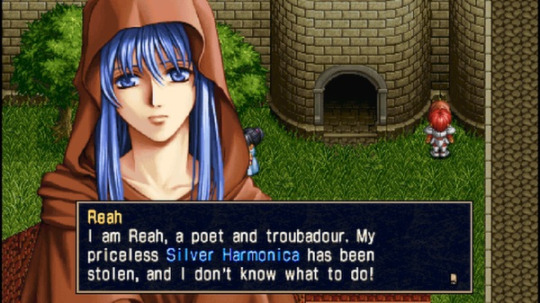
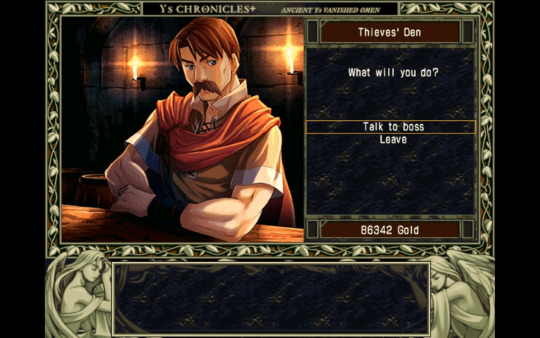
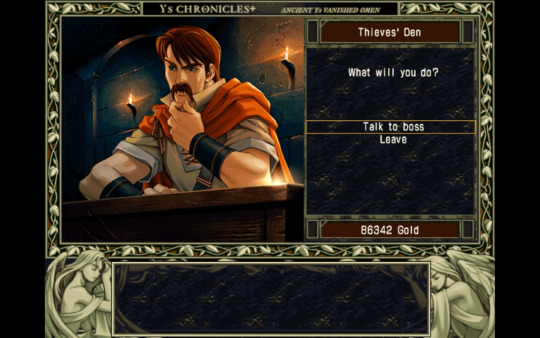
Sound:
Ys 1 has an absolutely fantastic soundtrack, courtesy of Yuzo Koshiro, also known for the soundtracks for The Revenge of Shinobi, Etrian Odyssey, and, probably most famously, Streets of Rage, setting a standard for Falcom games in general, and providing quite an influence on video game music as a whole. This version again gives options in regards to the soundtrack, giving three different versions to choose: the original soundtrack on the PC-88, which holds up well even today, the Complete soundtrack, which gives a refreshing and different take on several songs, even if it’s very blatant in being in MIDI at times, and a new soundtrack recorded specifically for this version yet again, which is amazingly metal. It, again, comes down to preference, though while I like all of them quite a bit, I easily like the Chronicles soundtrack best, though it’s telling when the original PC-88 version of the title screen theme, Feena, is just as pretty as the other versions. Speaking of which, when it comes to individual pieces, some big standouts to me are Feena, again, for the title screen, Palace of Destruction, the theme of the first dungeon, Fountain of Love, Minea’s theme, Tower of the Shadow of Death, the maddening theme of Darm Tower, and Dreaming, played during a memorable maze section of Darm Tower. It is, overall, among some of the best music I’ve heard in a game, and is worth looking up even if you otherwise have no interest in Ys.
Ys 2: Ancient Ys Vanished: The Final Chapter
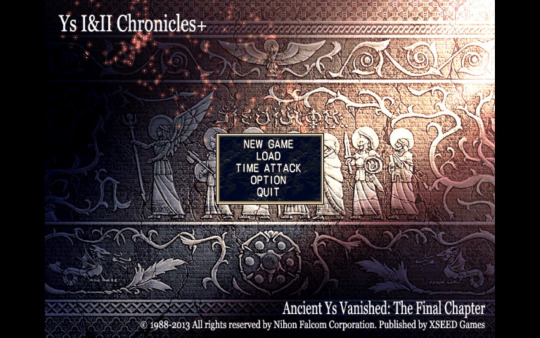
Ys 1 and 2 are so tightly connected to each other that I could not go without giving both games a proper looking through. Most releases of them nowadays can’t either, with almost everything bundling them together, which makes the short length of both a lot more acceptable, especially if you look at them as two split up parts of one game, like the acclaimed TurboGrafx-16 version did.
Story:
Ys 2 picks up right where Ys 1 left off, with Adol being transported to Ys itself. Unfortunately, his journey is not too smooth, resulting in him ending up unconscious and losing everything except for the six Books of Ys, eventually being rescued by a girl named Lilia and taken to her home of Lance Village. At least it wasn’t a shipwreck this time. But yes, as it turns out, people still live on Ys, and lived so in peace, until the same events that caused monsters to appear on Esteria caused the demons that once devastated Ys to reemerge. After being told that returning each tome to the sanctuaries of each great priest would open the way to the Shrine of Solomon, the former temple of the twin goddesses, and the current base of locations of the leaders of the demons, Adol sets off once again, to restore peace to Ys once and for all.
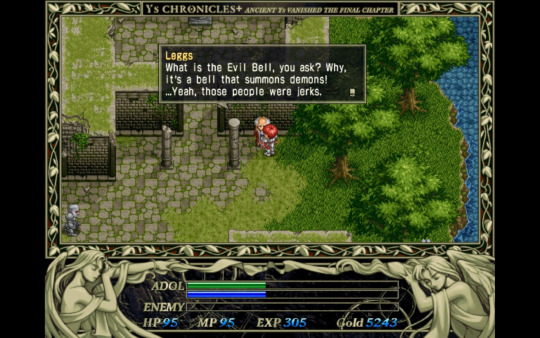
There unfortunately isn’t that much more for me to say regarding the writing. It’s about the same quality as the original when it comes to plot and characters, but overall, it’s a good conclusion to this tale, and the general dialogue is as entertaining as ever. I will say, though, that the tone works quite well, carrying a somber feeling reflecting the misery of the people of Ys, and their wish to return to happier times. Additionally, using a certain spell in the game, Adol is able to talk to the demons on friendly terms, and every one of them has unique dialogue. Not every type of enemy, every enemy has unique dialogue. Some of it is informative, but others just seem to be Falcom and/or XSEED going out of their way to prove how dedicated they are to detail, and I for one love it. Another notable thing to me is the setting of Ys itself. Esteria was a fairly normal location, but for such a mythical place... Ys itself isn’t too much different. It has some more extreme environments, like an ice wall and lava filled caverns, but it’s remarkably normal otherwise. While this may come off as disappointing, it fits quite well, considering Ys was never meant to be so grand and mysterious, and is a relatively normal place forced into an abnormal situation. Overall, again, it is a solid conclusion and step forward.

Gameplay:
The gameplay of Ys 2 is more or less the same as Ys 1, for the most part, divisive bump system and all. It does, however, feature several improvements, mostly to the combat. Firstly, the bump system has been changed so that ramming an enemy while moving diagonally will always count as a safe hit for Adol, making combat a lot safer, and enemies generally don’t deal as much damage either. The level system has also been revamped, going from the paltry level cap of 10 to a level cap of 55, meaning you’ll be leveling up and improving till the end of the game. Conversely, individual levels don’t mean nearly as much, but not only are they easier to grind for when necessary, they also make equipment much more important. The biggest gameplay addition, however, is the magic system. Over the course of the game, Adol gains several spells, most notably a spell to shoot fireballs, which can be shot rapidly or charged for a stronger attack, but also includes a spell to temporarily stop time, freezing enemies in place and leaving them defenseless, a passive, yet constantly active spell that reveals secret passages, a spell that allows Adol to appear as a demon, allowing the previously mentioned interactions, and even a spell that can warp him between various towns and other important locations, something that proves extremely helpful. This system alone adds so much to the game, and is a great way of expanding upon the rather limited system of the first game. Accessories have also been overhauled, as rather than just rings with simple effects, they’re various objects with much more unique effects, such as yet another ring that occasionally allows Adol to parry an attack, and an idol that gives homing properties to his fireballs. All bosses except for the last two now require the use of the fireball spell to defeat, making them a lot more reliant on skill than just being at the right level, making them a lot more fun as well, while retaining the frantic feel.

Another addition is the ability to give items like flowers and apples to NPCs as gifts. A few of them will reward you with valuable information, or even items, but for the majority, all you get is some amusing dialogue, all of which is unique, once again proving how insane these writers and localizers can be. You can also choose to throw fireballs at them, causing them to shout some pretty funny comments, which often include references to other games like River City Ransom and Final Fantasy 6. Still, it’s not very practical considering it lowers their affection, requiring more gifts just to get back to neutral. While it doesn’t affect normal dialogue, this little system is worth messing around with, just to see what laughs you can get from it.

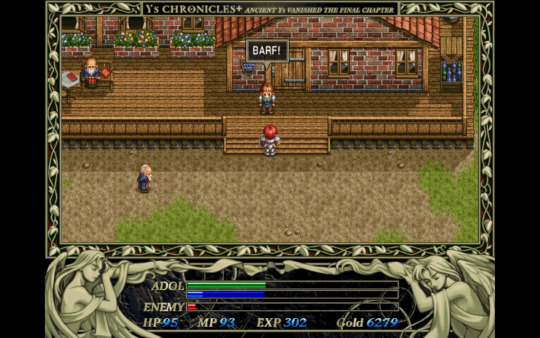
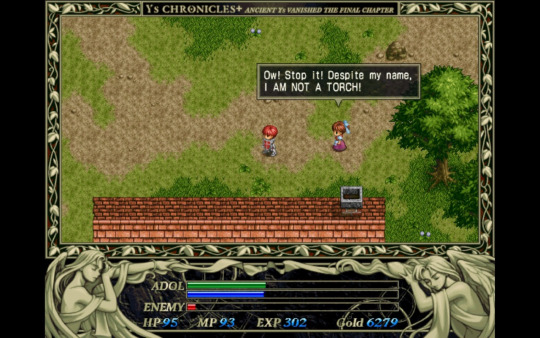
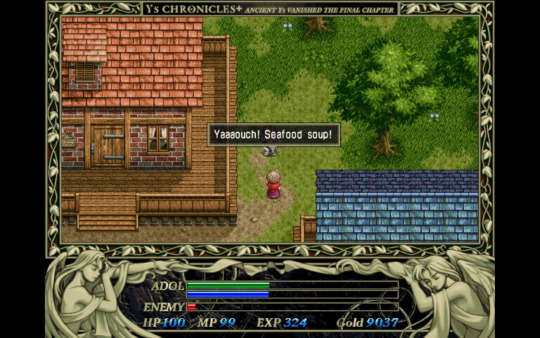
Otherwise, the game is more fleshed out, with a lot more places to go to. You’ve got a shrine and a mine combined into one general dungeon, a beautiful ice wall, volcanic caverns, and finally, the Shrine of Solomon. Compared to Darm Tower, the Shrine of Solomon isn’t quite as dominating, but it’s still huge, and sadly still requires a lot of backtracking. I’d wager it’s about a fourth of the game in of itself, possibly a third if you’re quick enough with the rest, and can still get pretty draining. Still, it’s a lot more enjoyable than Darm Tower, having more interesting environments, such as plenty of outdoor areas and a subterranean canal, and certainly lives up to the hype itself had built up. There’s no overworld, but considering how you were gated off by anything you weren’t a high enough level to take on in Ys 1, combined with how tiny and featureless said overworld was regardless, this linearity is preferable, giving a nice sense of progression. There’s also 4 towns spread out quite nicely, giving some much needed breathers after some of the more expansive parts of the game. The game is a decent bit longer than Ys 1, especially if you allow yourself to goof off and take in all the detail, like I did. Overall, Ys 2 has some much improved gameplay, and is a lot more fun than the already enjoyable first game.
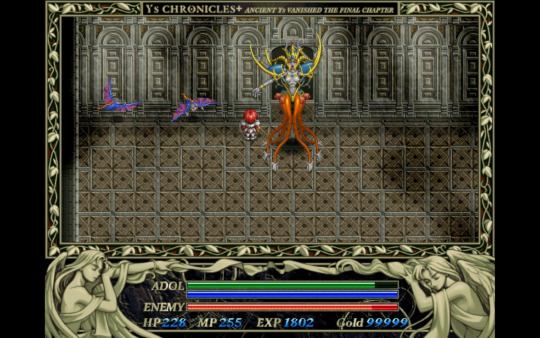
Graphics:
The graphics of Ys 2 are about the same level as Ys 1, namely, it looks great, especially the character artwork. One noticeable improvement comes in the area and enemy design, looking a lot more distinct than in the first game, making it all look a lot better. There’s also a dumb, but cute option that lets you hang a “mascot” on the screen, which just amounts to the sprites of various characters and enemies, more characters unlocking at maximum affection. Otherwise, I could just copy and paste I said in this section for the first game. Still, very good.
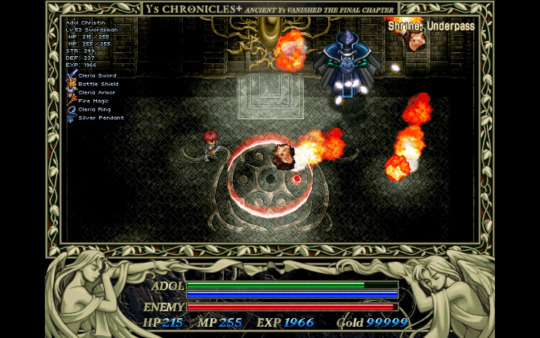
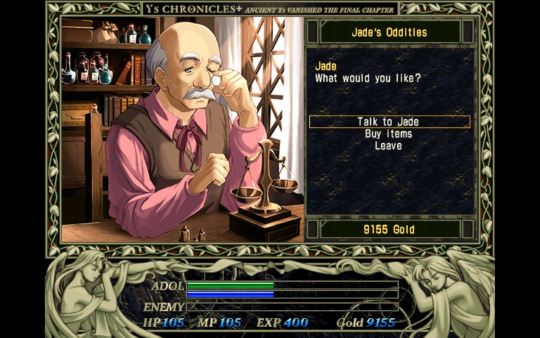
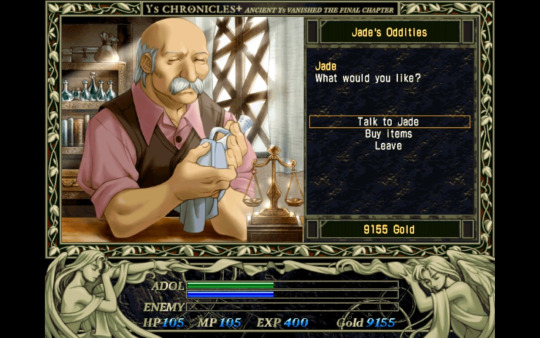
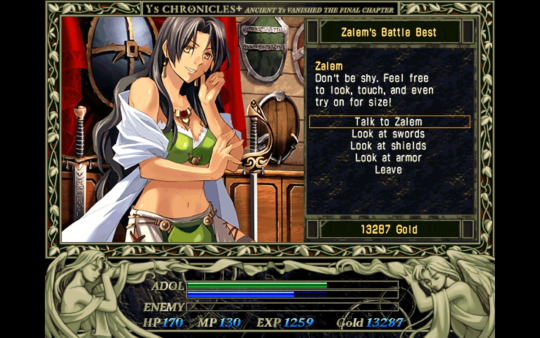
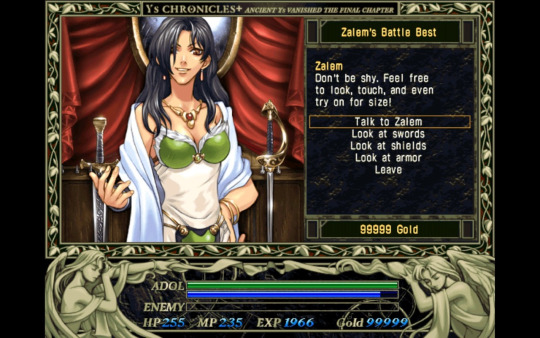
Sound:
The music, again, is very similar in quality to the first Ys, and is still amazing. Personally, I find the Complete remixes are a bit weaker compared to the first game, but the Chronicles soundtrack still hold strong. Some stand out pieces to me include Too Full of Love, Lance Village’s theme, Ruins of Moondoria, Ice Ridge of Noltia, Palace of Solomon, Tender People, Ramia Village’s theme, and this game’s remix of Feena, which is even better than the version in Ys 1. Overall, still a fantastic followup.

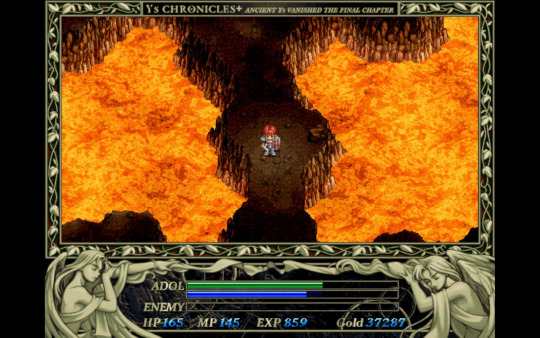
Conclusion:
Overall, Ys 1 & 2 Chronicles gets a recommended from me. It’s short length, questionable combat system, and overall signs of age can certainly be enough to make one wary, but getting past that leaves you with two games full of charm and passion. More than anything, they feel rather comfortable and relaxed. The shorter length, the various options for graphics and music, the general charm of it, and even the goofy and often context-less achievements, these two games manage to be memorable experiences.

This collection is a great introduction to one of the grandfathers of RPGs, a grandfather that’s still going strong after more than 30 years. Till next time, and apologies to anyone who reads this for how horrendously long this ended up.
-Scout
3 notes
·
View notes
Text
Here’s my KH3 review:
I would like to start off by saying I enjoyed this game very much. I have a lot of good to say about this game, but also a lot of bad. I tried to keep it spoiler free, but once I reached the cons it was inevitable. Heads up on that. And I also tried not to dive too deep into critiquing the story itself too much. I did sorta do that at the end though, but I felt it was okay to include the points I mentioned because they’re about Org. 13 and X and this game concludes their story arc.
Pros: The game is visually stunning. The worlds are GIGANTIC. It was a little intimidating actually. I always had the thought that I was going to miss something in the back of my mind. But it was still a joy to explore. The scenery really felt alive. The grass moved with you, the water rippled, you can see Sora’s hair move when it was windy! My favorite world in 3 is Kingdom of Corona. It’s just so beautiful and so fun! In this world especially, you interact with Rapunzel as she explores her environment because she’s never experienced it before. It’s really cute and really gets you involved in the world besides just being the guy that takes out heartless.
Another pro is: Yoko Shimomura did it again! Her music compositions for 3 are AMAZING! I got into the music right away and eventually found myself humming to every background song in no time flat. I also enjoyed how every world had more than 2 themes this time. Usually we had a ‘calm’ world theme and a ‘battle’ world theme. Yoko went beyond that and gave us a different theme per situation… for EACH world! One example is in Frozen: we had a theme for the mountain, a battle theme, and a theme for after they met Larxene (and she did the thing if you’ve played the game lol). My favorite theme is the one for Hiro’s Garage in Sanfransokyo. It’s so soothing; I could listen to it for hours. The theme for Aqua’s battle is totally creepy and it fits so well. I enjoyed all of the music.
Game play is fun and really nostalgic. They brought back equipping abilities (with AP), the old command box from 2, and accessories. Magic is better than ever in this game. One problem I had with 2 is that I could only use a few spells and my MP level would quickly run out so I felt it was a waste of time. In 3, even just starting, I didn’t have to worry about running out as fast. It was a relief not having to worry about watching my MP levels and I used magic a lot more in this game.
A new combat feature for 3 is the keyblade transformations. When you finish a world and gain a keyblade, you can unlock special abilities with that keyblade. For example: if you equip the Toybox keyblade, and you bash enough heartless with it, you can transform your keyblade into a giant hammer. I wasn’t too excited about it when they first revealed these new abilities during development, but they’re actually super fun and totally optional if you really don’t dig it. You can also switch between 3 different keyblades during combat easily if you feel one keyblade isn’t working out against an enemy. I love this new feature. My favorite keyblade transformations are the Toybox hammer and the Monstropolis Yo-yos. Sora is channeling his inner Killua with the Yo-yos and I am all for that lol.
Another pro is Sora, Donald, and Goofy’s interactions. Like, omg, they are so cute. They are so genuine. It really felt like I was watching Sora and his two Disney dads. It gave me life and I felt so many emotions watching them. This trio was the best developed trio in 3.
Cons: Pacing y’all. My biggest problem with this game as a whole. It started off good, but once you finish the Disney worlds and get into the real plot with Xehanort it’s like a rollercoaster and not in a good way. All the things we were hoping to happen, that we’ve been waiting for for years, happen so quickly and then it’s over like… did it even happen? I felt I didn’t get to be as emotional about those scenes as I could have been because they immediately thrust us into another scene. I didn’t have time to appreciate those moments like I wanted to.
Kairi…. Poor Kairi. Nomura screwed her over again. He let us get hyped about her finally training to become a keyblade wielder, gave her a new outfit, and showed her willing and ready to fight in the Keyblade Graveyard and yet? Screwed all of us. I wasn’t expecting her to be a badass, but I was expecting her to be SOMETHING. I was really hoping she’d develop a personality and presence in this game, but she fell flat yet again because Nomura doesn’t know what to do with her. She literally only exists as a plot device and love interest for Sora (I’m not going to get into that here lol).
Also disappointed they hyped playable Riku, but it was only 2 times, for 2 battles and frankly switching between Sora’s magic command menu to Riku’s with no time to look through it and get accustomed to it other than during actual combat was a pain. Also sad Sora, Riku, or Kairi didn’t travel to ONE world together. Not one. I was hoping to have them in my party as least once, but nope. I’m generally disappointed in the lack of Destiny Island trio interactions. There were no moments between the 3 of them and there was no interaction between Riku and Kairi and barely any between Sora and Riku despite growing so close in DDD. It goes to show Nomura didn’t develop this ‘trio’ as well as the others.
Another problem I had were almost all the Organization members ended up… being ‘good after all’ or something. For over 10 years they gave no indication Luxord, Larxene, and Marluxia were nothing, but just evil just because and they had no feelings towards Sora other than a boy that was in their way, but once they start fading away for good it’s suddenly, ‘you’re a great person, Sora. Let’s meet again’ or in the case of Larxene, just giving Sora the time of day and actually talking to him civilly just felt so random to me. Including Xemnas. He suddenly revealed how he felt sorta bad for betraying the old organization members, but there was literally no hint of that before?? Idk, it just felt out of place. I was kinda cringing the whole time, haha. I’m actually surprised YX was the one that disappeared the most unremorseful for his (future) actions.
And then there was Xehanort, omg. He literally destroyed the lives of dozens of people, almost sent the world into the apocalypse, and had this grand scheme for the last 15+ years that he literally invested multiple lives to see fulfilled, but once his old bff Eraqus tells him ‘you’re done’, he went, ‘okay’. Lol wat? That’s it? I’m sure he knew he lost, but I expected more of a grumbling, complaining old man on the brink of death than just a nonchalant, ‘you done good kids’ while giving the x-blade to Sora with a damn smile on his face. I cringed. It all felt unfulfilling to me at that moment because X gave up too easily and was so OOC. I think Nomura just wanted to wrap up this story real quick and move on with his life.
And another thing! 3 didn’t go into Xehanort’s past. They gave us some cutscenes of X and Eraqus playing chess and flirting, but that’s it. When did their relationship change? What made Xehanort so obsessed with dark and light balancing? When did he meet Braig? What happened to Scala ad Caelum? Does it still exist? Like…. They didn’t go into X’s background AT ALL. I was really hoping to see more about his character.
Neutral feelings: I remember reading somewhere that 3 was supposed to be the longest game in the series, but I finished the game in about the same time as the others. So maybe they meant longest game gameplay wise and not story wise. On the plus side, there is a TON of stuff to do in this game like a bunch of mini games, cooking with Remy, finding lucky emblems, and exploring worlds after they’re completed. On the downside though, even just 10 more minutes of cutscenes could have helped the pacing in the later part of the game. The gameplay and story are imbalanced and they should have focused on solidifying the story rather than adding so many different gameplay elements. I honestly find them all overwhelming. I stopped trying to remember them all.
The Disney attraction rides. I don’t really have a like or dislike for these reaction commands. Good thing is that some are fun to see visually like the train and the tea cups (Sora is so dang cute in those teacups). Downside is some attractions don’t seem to fit with the heartless that activate them. For example: that shooting attraction ride is terrible with flying type heartless and yet I get that command a lot with them so it’s pointless. I never hit them.
This is a con for me, but maybe not for others. They closed a big chapter in the game, but kept a lot of plot points open too. I think my main problem with 3 was that I was hoping it would be more conclusive. Nomura made it seem like it was more conclusive. I already knew 3 wasn’t the end of the series as a whole, but you can still end a storyline with a definite conclusion while still being open to new adventures. 3 didn’t do that. They closed a bunch of chapters, but also left us with a lot of new questions.
Most of the voice acting is great in this game! Haley really delivered as Sora and I honestly think this was his best performance as him to date! It was genuine, totally cute, and fit Sora perfectly. You can tell he had a great time voicing this game. I also really enjoyed Larxene which is something for me because I felt her VA was trying too hard in CoM. She really improved in 3 and it was fun to watch her. On the other hand, the voices for Xehanort and Marluxia fell flat. Xehanort’s is just unfortunate and I don’t think anyone could have captured him as well as Nimoy did no matter how much they tried. Marluxia sounded like he belonged in an infomercial. Totally hated his voice.
18 notes
·
View notes
Text
Writer Journal Entry
//As you may have guessed by that last post, I’ve been playing through a bit of Golden Sun: The Broken Seal.
It was the first time that I’ve played that game, and it certainly has proven… enlightening, to say the least.
There are things I now know a lot more about.
I know a lot more about Vale and the people who lived there, and how they viewed the whole thing.
—There was one man in particular who cared about Felix, and believed in him. No one else in Vale outside of Felix’s family (particularly his grandfather) showed much concern, or had anything nice to say. Anyone else who made comments only cared about Jenna—even though they knew Felix was alive. While negativity could be understood, the sheer apathy that exists instead really stands out and drives home the point that—as a community—Vale didn’t care about what happened to Felix.
—Vale was also astonishingly ignorant. When I wrote Saturos and Proxans in generally talking trash on this matter, I really didn’t understand just how true it was. They have long forgotten exactly what they were supposed to be protecting, which in turn relates to their own village history—as well as world history.
In the IALS timeline, the Venus Clan were nomads with no centralized location. Venus Lighthouse was one of the few times—if not the only time—the surviving Clan members of that continent came together to build something. They were largely wiped out by the Mars Clan as part of the campaign the Proxan Empire waged against the Mercury Clan.
If they had remembered more of their history, they would have known what was in Sol Sanctum, and known that the Proxans were not good news. Granted, that would have made it much harder to actually save the world… unless the progress Kraden made with knowing that much sooner could have offset it enough to the point of allowing for open discussion.
Felix is actually ashamed on this point, and is one of the main reasons why he has come to view himself as a Proxan, not a Valean.
—On a hilarious note, Felix left his wallet behind in Vale after his group took the Elemental Stars. I find it to be a bit of dramatic irony—because that is exactly what happened/happens at the end of IALS.
—I have now actually played through Sol Sanctum, Mercury Lighthouse, the Silk Road, Venus Lighthouse, and the deserts. This gives me a better understanding of the setting (mostly the terrain) regarding incidents in those locations.
—I noticed that Sol Sanctum had a minotaur theme going on, which was quite interesting. The Sol and Luna content there was very rich—and it’s worth noting that although the Sanctum is explicitly connected to the sun, it’s changing things to the moon that actually makes things happen. I find that to be very important, and will be studying it in greater depth later.
—One of the important plot points for IALS is how Felix is the only person to have held all four Elemental Stars and been present at the aeries when lighting all the beacons. That does present a bit of a narrative puzzle for Sol Sanctum, though. After some thought, here is my answer:
Isaac took the Venus Star, following the instructions Kraden gave. Garet got jealous and took the Mercury Star, which hurt him pretty badly. Garet felt short-handed, so he also took the Jupiter Star—but used the Mythril bag properly this time.
—Worth noting that Sol Sanctum also showed us that Isaac literally does not possess the willpower to stand up to the Wise One, even if he wanted to. Which is a rather important detail in his characterization, and manifests in his interactions with other authority figures down the road.
—It’s outright stated that it’s Felix’s destiny/fate to light the Lighthouses and restore Alchemy to the world. Destiny and fate are one of the philosophical points that Felix muses on over the course of IALS, so that in and of itself is interesting. However, the fact that it was stated this way means several things:
Isaac joined up with Felix later, but only Felix is mentioned. Gameplay conventions aside, this means that Felix _specifically_ is destined to do this. It is his burden specifically—a burden Hama mentions later. While it means that Felix specifically saves the world, and Isaac just tags along (after he stops hindering and arguably making things worse)… it also means that a lot of blame is saddled onto him and him alone.
Whenever something bad happens in the wake of Saturos and Mendari’s group, it’s almost always Felix who gets the blame. His name is mentioned several times in this context… and particularly to Iodem, who would later take over the helm of the Tolbi Empire.
Nice work there, Isaac. No wonder the Sagas have so much hate for your brother-in-law—you publicly blamed him for everything. : |
—I actually wouldn’t add on too much about my earlier description of Mercury Lighthouse. The part that most sticks out in my mind was the walking across water and how dangerous that was, which was the part Felix focused on, too. Understandably, given his past with deep water.
I can now confirm that Alex and Saturos traveled separate from the main group for quite some time, and that Saturos remained pretty heavily injured. I wouldn’t put it past Saturos to be too proud to accept help from Alex unless he weren’t strong enough to brush him off in that given moment.
—I’d go over the scenes involving the Silk Road in greater detail, if given the opportunity. Now that WAS Felix’s fault specifically, but it was an accident. It would serve as a good transition point to show how his power has started to grow in the presence of the Venus Star, and would also help make their line of travel less vague.
—It is said that Saturos took the group through the evil desert. It is also asked how they would survive. The answer was “they’re Mars Adepts”. No mention is made of the other four travelers. :V
While this was known, I couldn’t really appreciate how terrible of a journey that must have been until after walking through it myself. I kept getting lost. If anything, I’d make that journey even worse on them. It’s amazing that Kraden didn’t die—and I’m going to chalk that up to being around Mercury Lighthouse and the Mercury Star just long enough to tough it out alongside the others, with Alex’s help.
—The Altmiller Cave has architecture and visual elements that suggest some sort of connection to Venus Adepts, if not Venus Lighthouse. Again, something I will research more, later. (Unfortunately, Felix never went there, and the chances of being able to do so are minuscule at best—far too directly connected to Tolbi.)
—The whole end segment with the desert, Lalivero, the ruins, and Venus Lighthouse is a lot more complex than I had properly been able to appreciate as I was working on it over the years. There was quite a lot of back-and-forth in the matter, making it quite chaotic. I’d go into greater detail if I get the chance, but I’ll need to replay the segments a few times to properly get a grasp.
More on all this soon.
3 notes
·
View notes
Text
Thoughts on Dark Souls 3
(Note: I made this right after I finished the base game back in April. I just wanted to clean this up and get it published while going through my drafts. This only applies to the base game.)
All right, first off, I’m going to clarify that I love Dark Souls 3 and have not played Dark Souls 1 (was too young when it came out to play an M-rated game).
That being said, Dark Souls 3 has some serious issues. I know Fromsoft will never see this, and in all honesty most companies should ignore everything on tumblr (otherwise BioWare’s future games would be awful, awful, awful and Overwatch would be doomed). I still wanted to verbalize this, though.
1: The Bosses
I cannot be the only person who thinks that, ironically, Dark Souls 3 has more “Armored Knight” bosses than Dark Souls 2.
I mean, if we compare the bosses, there are 32 in Dark Souls 2.
The following could count as “Dudes in Armor”:
The Pursuer
The Looking Glass Knight
The Ruin Sentinels
The Old Dragonslayer
Velstadt, the Royal Aegis (who is awesome)
Vendrick (who’s naked, so maybe it doesn’t count?)
The Dragonriders/The Twin Dragonriders (counting these as two bosses)
Throne Watcher and Throne Defender
The Gank Squad (okay, only two of them are in armor, but we’ll just count these guys/girls/whatever)
Sir Alonne (who is awesome)
Fume Knight (who is super awesome)
Burnt Ivory King
So that’s...thirteen bosses out of 32, twelve if we exclude Vendrick. Of the 23 bosses in the vanilla game, 10 of them are dudes in armor (9 if you exclude Vendrick).
Let’s compare that to Dark Souls 3. Of the 19 bosses, the following could be counted as “Dudes in Armor”:
Iudex Gundyr (or, at least, his first phase)
Vordt of the Boreal Valley (he’s got the behavior of an animal, but still counts)
The Abyss Watchers
Pontiff Sulyvahn (who is a great boss)
Dancer of the Boreal Valley
Champion Gundyr
Lorian, Elder Prince, and Lothric, Younger Prince (okay, only one of them is in armor and the boss is badass, but c’mon, they count)
Nameless King (phase 2)
Soul of Cinder
So, that’s 9 out of 19.
So 47% of the Dark Souls 3 bosses are armored knights, while 37% of the Dark Souls 2 bosses are (counting the DLC and excluding Vendrick: it’s 40% if we count the base game without Vendrick). So, percentage wise, I’m mostly splitting hairs since the difference doesn’t seem substantial (although 10% is nothing to ignore, so we’ll have to wait and see how the DS3 DLC shapes up).
While the overall quality of the non-knight bosses in Dark Souls 3 is better compared to those in Dark Souls 2 (Prowling Magus, Blue Smelter, and Royal Rat Vanguard, I’m looking at you), I still feel a bit disappointed in the buildup to the bosses in DS3. Plus, there aren’t all that many optional bosses, and, except the entirety of the Archdragon Peak area, most of these optional bosses aren’t well-hidden.
Remember exploring the now-unlocked areas in the Lost Bastille and coming across the Gargoyles and the Bellkeeper covenant, or finding the Darklurker at the end of the Pilgrim questline? There aren’t too any bosses like that in DS3. The DLC might fix this, though.
The Lords of Cinder are quite good, but two exceptions stand out; Yhorm and Aldrich. While Yhorm’s fight is a love letter to a Demon’s Souls boss, it still feels like it embodies a critical flaw in the game; sacrificing interesting or innovative ideas on the altar of nostalgia. Aldrich is appropriately horrifying and a gut-punch to DS1 players, but after the initial shock, goes down without too much trouble. On the other hand, the Soul of Cinder is an epic love letter to Dark Souls 1 and 2, and many of the other bosses are excellent additions to the Souls boss repertoire, there are still plenty of disappointments (Deacons of the Deep, Crystal Sage, Ancient Wyvern, and the Greatwood [arguably]).
So, in conclusion, while the bosses are excellent, I hope the DLCs do a bit more to hide the optional ones, increase the number of optional ones, and diversify the boss lineup.
2: The PVP
I’ll be careful about blanket statements, but the PVP seems to have overall been received much more poorly in Dark Souls 3 compared to Dark Souls 2. Part of this is flaws in the covenant design, but a lot of it is the core design choices of this game and how they differ from before.
Let’s start with the positives. The absence of Soul Memory is an obvious plus, making it much easier to find appropriately-leveled and geared friends and enemies. The online connectivity is the best it’s ever been, with fewer instances of game-based lag, and generally smooth hitboxes even for notoriously problematic weapon classes. Covenants once again offer a place for players to carve themselves out in the world, and the differences between some of them lead to far more creative gameplay then we’ve ever seen before. Increasing the number of possible players in a world leads to even more chaotic brawls.
Unfortunately, there are a slew of negatives to go along with this.
For one, you can no longer be invaded in areas where you have cleared a boss; while I can understand the desire to make an area permanently “safer”, this means that end-game players are left in the lurch for areas to PVP in.
[NOTE: As of the original time of writing this, the arenas were not yet announced. With the presence of arenas, this issue has been largely addressed.]
All weapons in a weapon class have identical movesets. This makes it more fair when it comes to predicting possible attacks and helps unify weapon balance, but robs the ability of some weapons to stand out based on their specific moveset (Santier’s Spear, anyone?), meaning that good weapons are determined by stats alone and there are far fewer viable options.
On that note, Whips, Scythes, and Lances are essentially nonexistent or so poor as to be unviable choices (with the lone exception of Friede’s Great Scythe). Gone are the days when dual bleed whips were a viable strategies and the Grand Lance’s running attack was the terror of tight corridors.
And now, we come to poise. Whoo boy, poise. “Working as intended” memes aside, poise is a difficult issue to pin down. Making it too strong leads to the death of fast weapon builds and the overabundance of tanks. Unfortunately, the opposite occurred, and for a long time after launch, fast straight swords (Estoc and Dark Sword spam) ruled the meta, and running heavy armor was essentially worthless. The situation hasn’t been fixed, but people have adapted a bit.
Lastly, we need to address the covenants, which are the worst they’ve ever been. Never mind that some of the rewards are worthless or poorly placed (Mound-Makers get Warmth? Really?). For weeks after launch, auto-summon covenants (Blue Sentinels/Blades of the Darkmoon and the Watchdogs of Farron) weren’t working at all, making levelling up in these covenants a near impossibility. The Blue Sentinels/Blades of the Darkmoon were hit particularly hard by this, given that there are no rewards for joining the Way of the Blue and thus people didn’t have much incentive to equip it, further killing the chances for “Bluebros” to get summoned.
Perhaps in anticipation of this, much like how covenant spells were available in NG++ from Chancellor Wellager in Dark Souls 2, some enemies drop covenant items. While they shouldn’t drop regularly enough to disincentivize online play, the drop rate for some items is inexcusable. I never want to see another Silver Knight again; far too many hours were wasted hunting for Proofs of a Concord Kept, and it’s only marginally better for Wolf’s Blood Swordgrass and Pale Tongues.
That being said, the positive from above are worth noting, and being able to swap covenants instantly and keep progress is a welcome and overdue boon.
3: The Levels
I’ll preface this by pointing out that the levels in Dark Souls 3, mostly, are vast, interconnected webs with shortcuts, interesting navigational tricks, and clear connections to other areas. From the tower in Farron Keep, for example, you can see the Undead Settlement, the High Wall of Lothric and Lothric Castle, the Cathedral of the Deep, and (maybe) Irithyll of the Boreal Valley. The areas make good use of verticality and looping-back to feed into a growing sense of comfort with the ins and outs of a place of exploration.This is all fantastic.
However, in terms of the sheer variety, Dark Souls 3 feels like it drops the ball. A few too many areas have the ambiance of a cathedral (sections that stand out in particular include parts of the High Wall of Lothric and the entirety of the Cathedral of the Deep, excluding the graveyard portion), to the extent that once you get to areas like Lothric Castle, I was a little sick of grand arches and choir chambers. Plus, almost every area you visit has already been colonized, inhabited, or otherwise has some continuous sentient presence. The primary reason areas like the Untended Graves stood out, aside from the genuine creepiness of the whole place, was the sensation of isolation that wasn’t really present when tearing through the Undead Settlement or Irithyll of the Boreal Valley.
In addition, some areas are of baffling length given their placement. The Road of Sacrifices feels poorly paced; besides the section with Corvians at the beginning, one can essentially bolt in a straight line from Anri and Horace to either of the two connecting areas. Though the Consumed King’s Garden and Smouldering Lake are optional, these areas have the distinct sensation of halting at awkward times. The Garden has a few wandering abyss-snake dudes and some confusingly-placed Cathedral Knights, but ends after a single shortcut. The Smouldering Lake is a confusing mess of tunnels that can be skipped by…running in a straight line from the entrance, if one is ballsy enough. Sure, deactivating the ballista is an interesting operation, as is finding all the goodies, but the Lake does feel like a strange tribute to DS1’s most hated area. Anor Londo made a little bit of sense as a beloved an important area from DS1, but Lost Izalith?
Unfortnately, the Profaned Capital does not have “it’s optional” as an excuse. After the confusing but rewarding hell of the Irithyll Dungeon, an area with the tagline “Profaned Capital” brings to mind something more like Lothric Castle, but instead is a very fast L-shaped pathway towards a boss that sacrifices interesting mechanics for nostalgia, with an optional hellswamp.
On that note, the amount of poison in Dark Souls 3 feels a little overbearing. Farron Keep on its own is worse than any previous poison zone, and even if they’re short, the Consumed King’s Garden and the swamp section of the Profaned Capital feel like an extra kick in the nuts.
The larger problem I have with the level design is actually less the level design, and more the world design with respect to player choice. Dark Souls 3 is pretty much a linear shot the whole way through, with only two notable diverging points; whether you kill the Deacons of the Deep before clearing the Catacombs of Carthus, and whether you kill Aldrich or Yhorm first. Technically, one can also get to Lothric Castle early by fighting the Dancer of the Boreal Valley before Vordt, but you can’t a actually get to the Lorian and Lothric, or even the Grand Archives, early. In comparison to Dark Souls 2, where you could not only choose which area to go to first (within a limited framework), but also which boss you could fight first, the restriction feels more than a little unwelcome.
That being said, most of the game’s areas are very well-designed. As mentioned, Irithyll Dungeon is a confusing, claustrophobic, terrifying and unforgiving environment, and the Cathedral of the Deep offers plenty of shortcuts (developer-made or otherwise) to make navigating the well-designed building easier. Archdragon Peak is of just the right size for an area so off the beaten path, and the Grand Archives are a fantastic final wall to throw up in front of players before the end of the game, involving heavy vertical as opposed to horizontal travel. And especially in comparison to Dark Souls 2, as mentioned above, even if the player has less choice in where to travel, the ways those areas link up is much more fluid and interesting.
On an unrelated note that I couldn’t think of any other place to put, the lack of differences between NG and NG+ and beyond are noticeable. In Dark Souls 2, new enemies and items were very common and the difficulty jump was noticeable. In Dark Souls 3, there are new rings, and that’s pretty much it. It’s a small issue, but combined with the lack of build variety, really hurts the game’s replayability.
4: The Story
The story is the part that hurts the most for me personally. While the characters and plotlines introduced in this game can be genuinely interesting, there’s no way to beat around the bush. Far too much of the story feels like it’s directly repeating Dark Souls 1.
While some of my complaints are to do with the dropping of interesting threads and characters from Dark Souls 2 (in the base game, there are a handful of items and areas referencing it, and the only enemies that carry over are the fucking poison bugs; even Yhorm turns out to not be a Dark Souls 2 Giant, although he’s implicitly related to the Giant Lord), I’m actually mostly frustrated because it means that the genuinely interesting threads from Dark Souls 3 get dropped. The entirety of material relating to “The Deep” ends up a dead end, Lothric itself feels like it’s repeating Lordran and Drangleic in uninteresting ways (even if that’s a theme of the series), and some of the most interesting original areas (Irithyll of the Boreal Valley, the Grand Archives) turn out to be connected at the hip to key elements of Dark Souls 1 that take over the new plotlines. Several new characters are essentially repeating roles from previous games, either in new coating (Lautrec for Leonhard), or even with the same appearance (Siegmeyer and Siegward [while I love both of them, the latter feels a little too much like silly fanservice at first]), and some of the new characters don’t…really go anywhere. Greirat finds an old woman’s bone and…dies after a while? Cornyx and Karla don’t go anywhere, although Karla has enough interesting questions to excuse her case.
And even for a Souls game, some of the material feels like such a tiny amount of substance is given to it that attempting to make connections is more frustrating than interesting. How on earth did VaatiVidya get enough material to make videos on the Angels of Lothric and Londor when very few items make any substantial connections? Again, what on earth is going on with Sulyvahn, the Church of the Deep, Carthus and more?
That being said, there are some excellent storylines and questions that pop up, and many of the previous callbacks enhance the story of the original Dark Souls. Again, the Untended Graves pops out as a positive, adding a great deal not only to the game’s story, but extending the importance of a seemingly silly character (Ludleth), and several storylines pan out in interesting ways. In general, the purely original elements of the story and characters stand out as great; some of the previous tie-backs fall comparatively flat.
Conclusions
Vocal people were spending the last 2 years whining about Dark Souls 2 and the developers tried so hard to recapture Dark Souls 1 that it kind of feels like DS3 fell flat in both respects. Genuinely good aspects from the second game were discarded for reasons that really aren’t clear, although they deserve props for learning from DS1′s mistakes and what DS2 didn’t do well.
I feel like Dark Souls 3...doesn’t really have its own identity. It blends elements from the previous entries very, very well but I genuinely think the story is too hung up on DS1, even with the excellent references to DS2 (Shield of Want and theories regarding Eleum Loyce being the Profaned Capital/Irithyll, anyone?).
Dark Souls 3 is an excellent game. At the same time, it feels like it’s trapped in an identity crisis between the first Dark Souls, and, occasionally BloodBorne.
#dark souls 3 spoilers#dark souls 2 spoilers#dark souls#post#i still love dark souls 3#but it has problems
2 notes
·
View notes